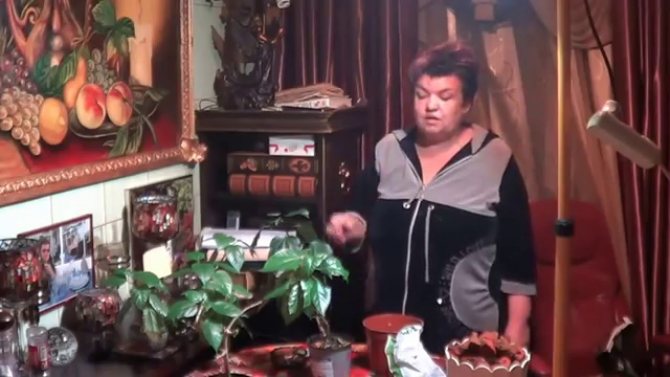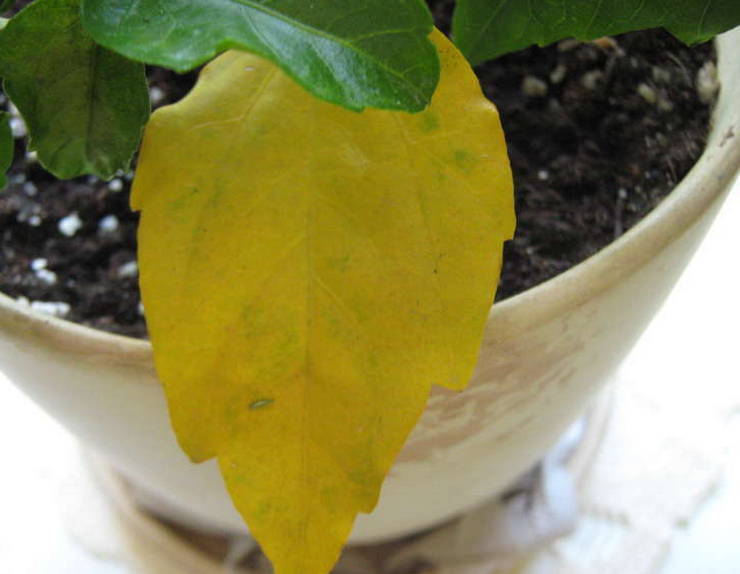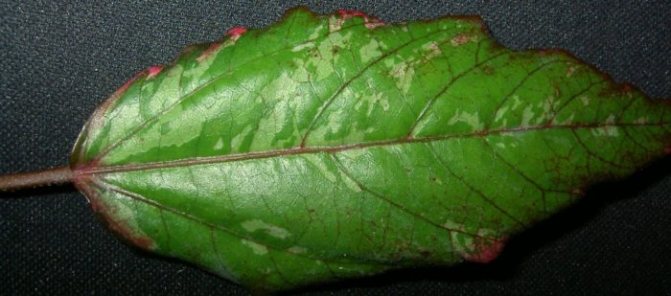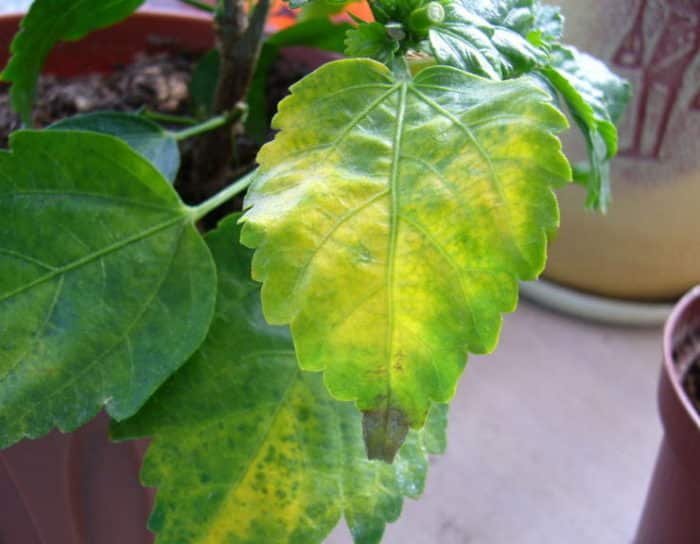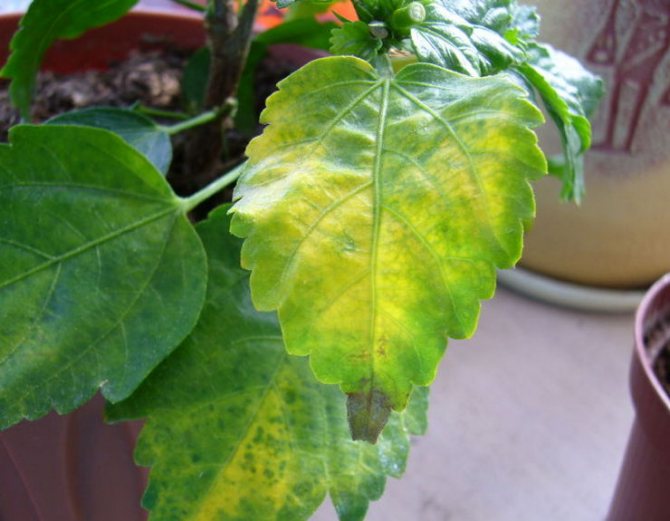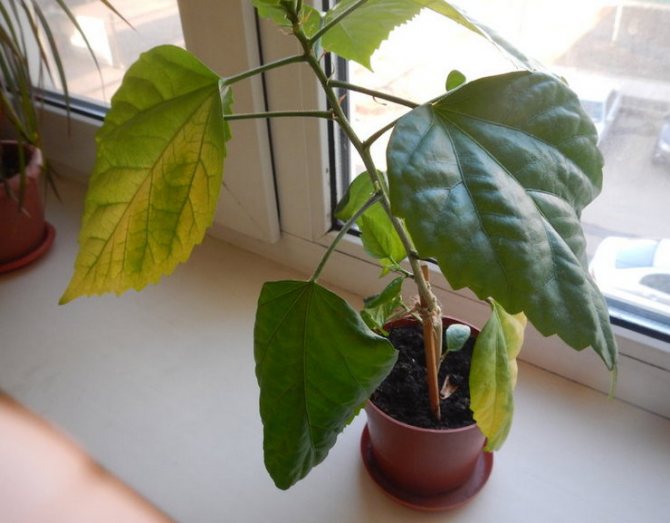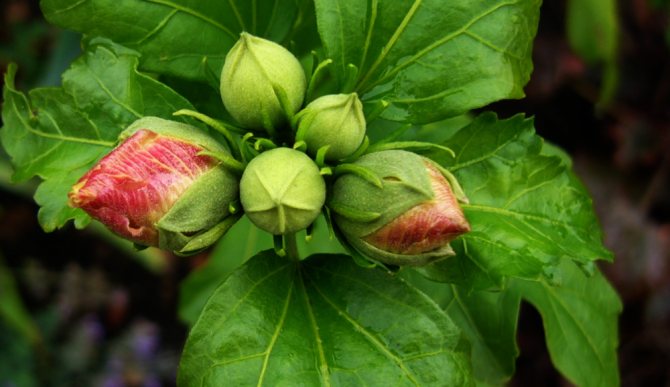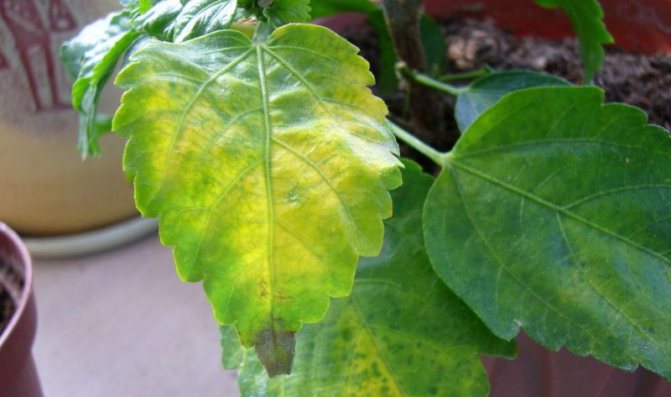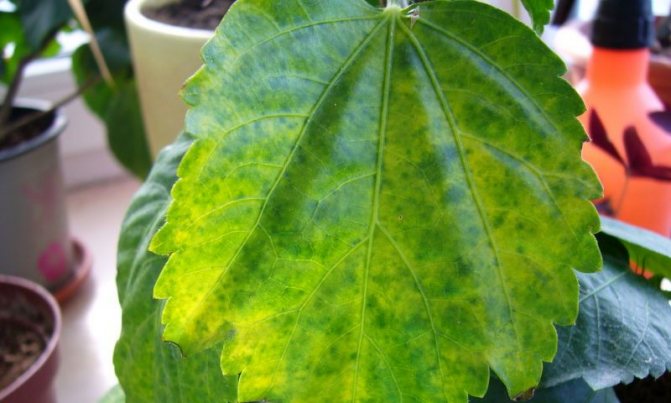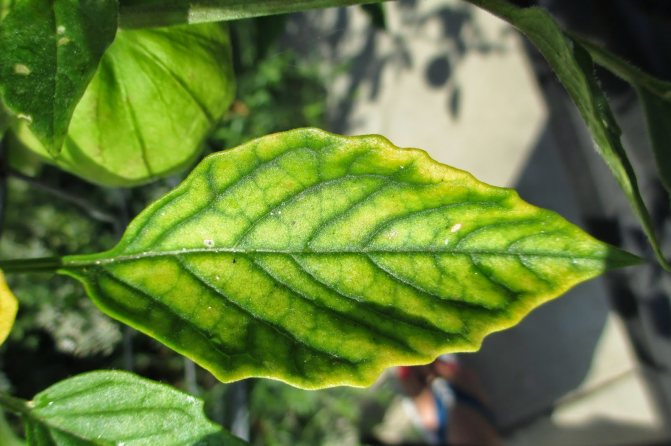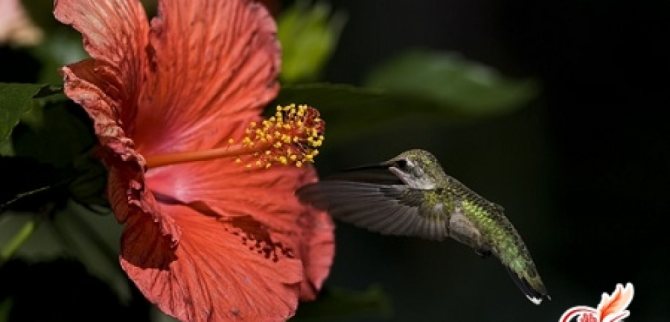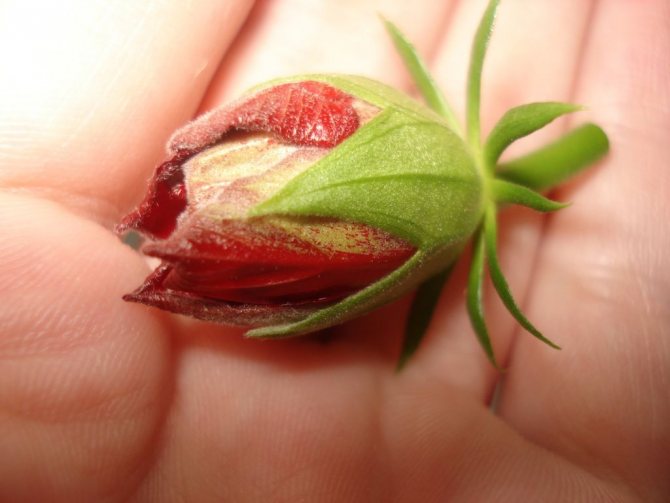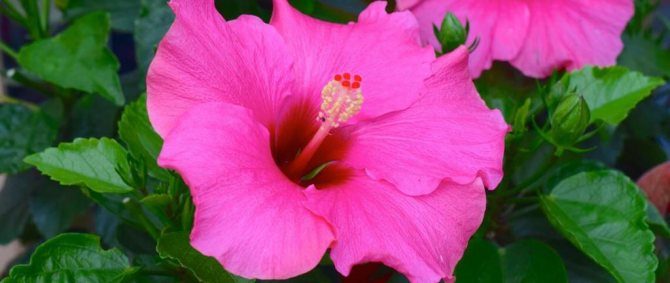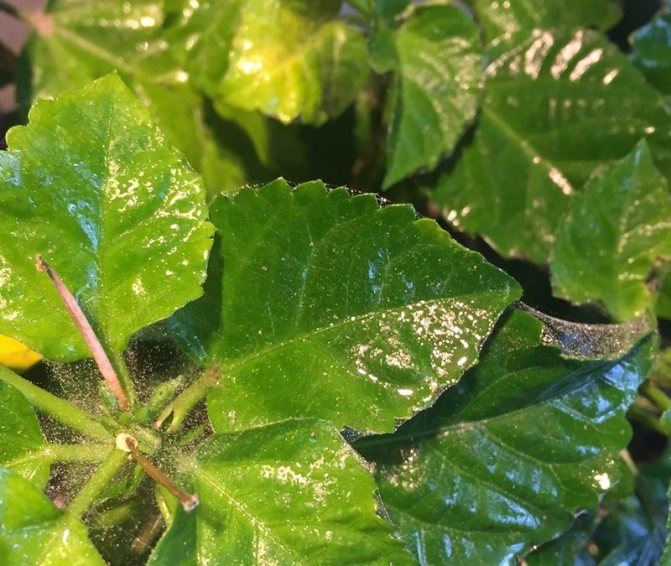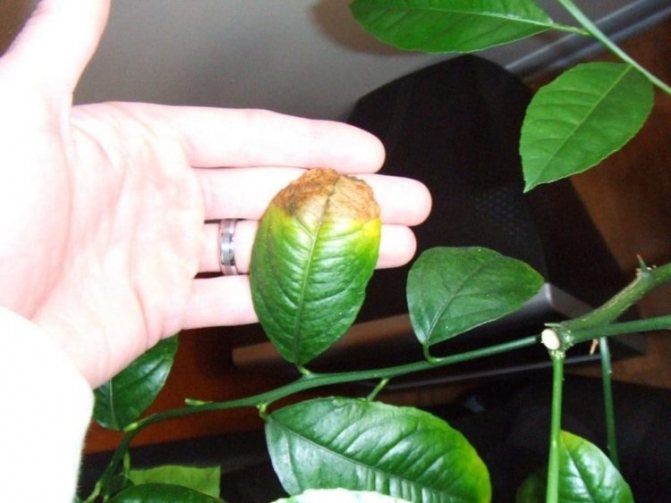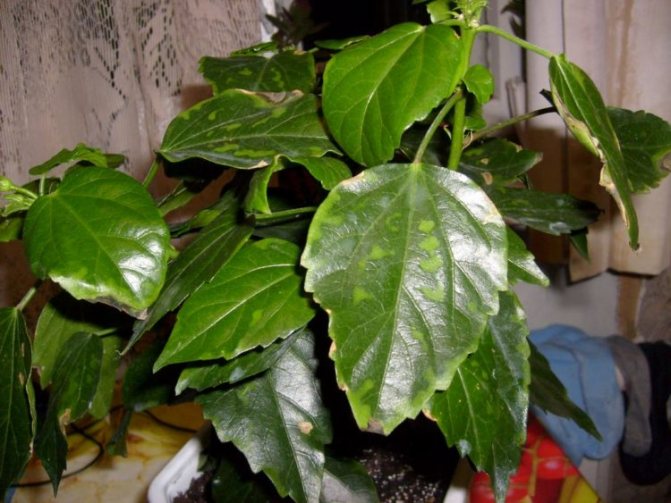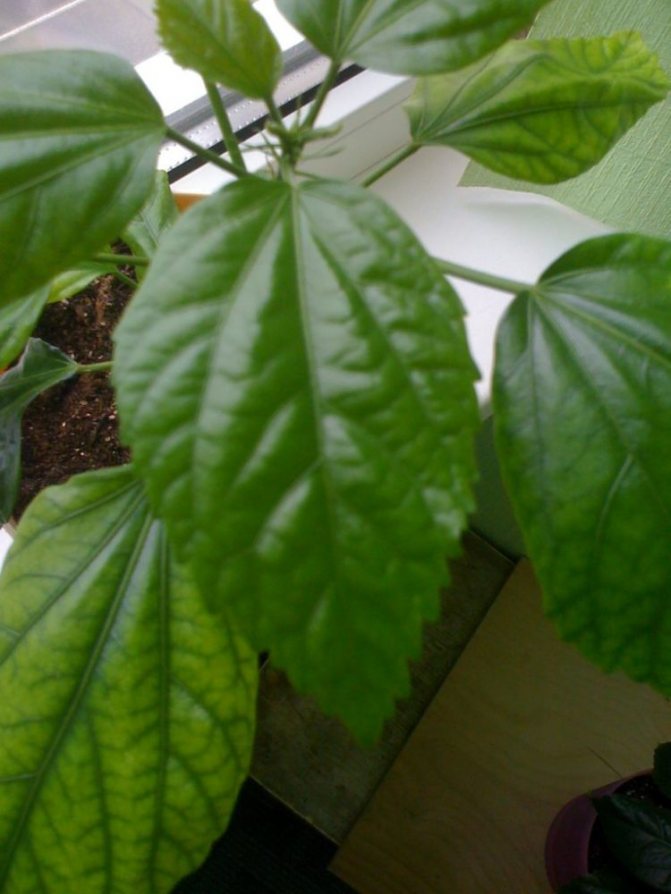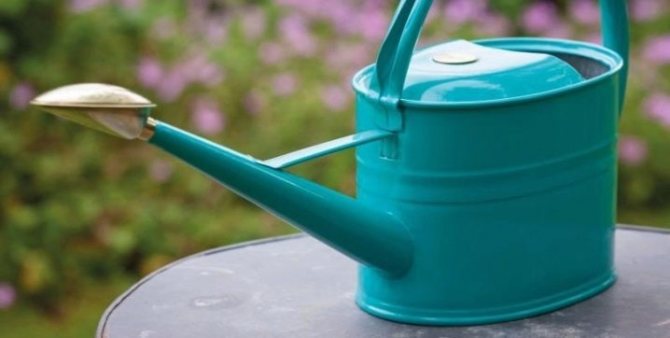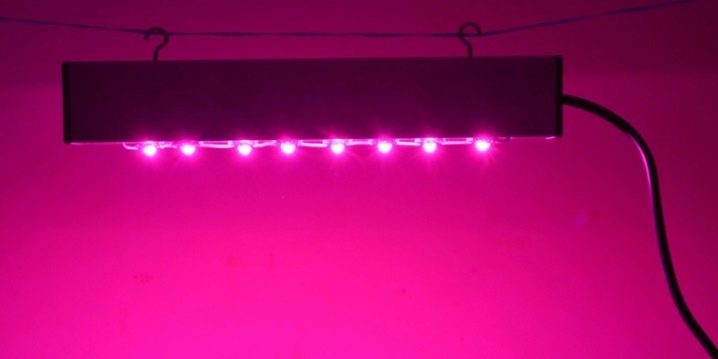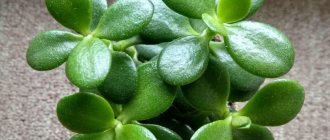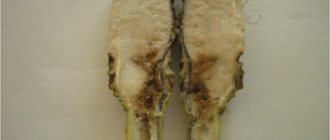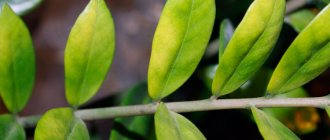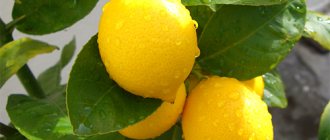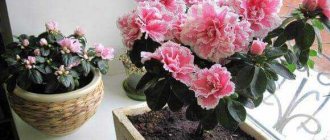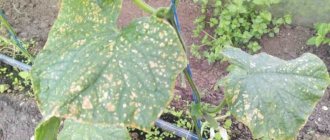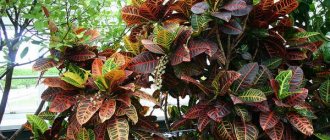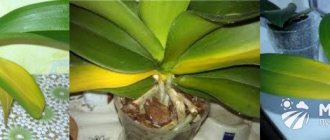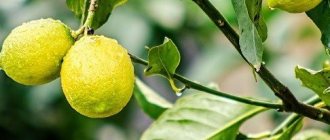The yellowing of the leaves of the Chinese rose occurs for the following reasons:
- Lack or excess of light. Direct sunlight hitting the leaf plates burns the surface of the leaf. Exposure to intense light destroys the green pigment in the leaves of the plant, causing them to turn yellow and then brown. Its lack also harms the culture, as the process of synthesizing nutrients is inhibited.
- Excess or lack of watering. Hibiscus prefers moderate soil moisture. In winter, water the culture every 2 weeks. Intensive watering will provoke rotting of the root system and the general wilting of the flower. Disadvantage - causes leaf fall and wilting.
- Air humidity. Rose loves humid air, dry indoor air will cause yellow foliage.
- Lack of space. A small pot provokes excessive compaction of the root system, which interferes with the development of the culture and leads to dropping and yellowing of the leaves. Transplant adult hibiscus into larger pots as needed.
- Temperature. Hibiscus is a tropical species, so keep the room temperature + 18… + 30 ° С. Cold sills and drafts are not suitable for this look. Temperatures above 30 ° C lead to overdrying of the soil, so water the flower more often during this period.
- A change of scenery. The plant prefers to be in one place in a pot. The constant rearrangement of hibiscus from place to place causes it to lose its decorative qualities.
- Nutrients. The lack of nutrients leads to chlorosis, which is expressed in the yellowing of the leaves. The leaf color changes from green to yellow gradually. Fertilize Chinese rose from spring to autumn with complex fertilizers once a week, in cold weather - once a month. It is important not to overdo it with feeding - hibiscus reacts poorly to an excess of phosphorus and turns yellow.
- Pests. Yellowing and curling of leaves can cause aphids. The problem is solved by treating the plant with Fitoverm.
If you take care of an indoor flower and fight diseases in time, the plant will bloom brightly.
The Chinese rose, if properly maintained, will delight you with its decorative effect and will decorate the windowsill.
Hello. What is the name of the variety of hibiscus that grows with me, I do not know (green leaves with white spots are edged with a crimson edge with the same veins throughout the leaf). lately, the white pigment from the leaves began to disappear, while the crimson darkened to burgundy and actively occupies the leaves, displacing even the green, sometimes manifesting itself with some terrible spots. Deciding that the draft was to blame (the hibiscus stood under the window, and it got very cold outside), she moved it to another window (part of the world was the same, the illumination did not change). As a result, several flowers still blossomed, then the buds began to turn yellow and fall off. The leaves seem to intend to do the same. The plant is very young (not a year old). Can you still help him? I would be grateful for your advice. Hello! Ekaterina, if you have a variegated form of hibiscus, then you shouldn't worry. If the hibiscus is ordinary, green-leaved, then the likely reason for the change in leaf color is a lack of nutrition, especially micronutrients. Feed not with liquid, but with complex mineral fertilizers such as Kemira Koibi or Orton Rost.Falling buds can also be associated with a lack of nutrition, as well as with temperature changes, lack of water and the movement of the plant to another place. The fact is that during the flowering of plants, in no case should you not only transplant, but even change their location within the window sill, and some plants are not even recommended to be turned. I can recommend spraying the leaves with Epin - this will help the plant to tolerate stressful situations less painfully.
Good luck to you. Hello! I have a very large hibiscus - 1.5 meters high. They took him to a new apartment - he immediately threw off the buds and the leaves began to turn yellow and fall off. What to do?!!!! Help! Hello! Elena, your hibiscus is under a lot of stress from changing conditions. In addition, you have made the most common mistake - changing the conditions for a plant that has already gained buds or is already flowering leads to just such results. During this period, it is advisable not to disturb the plants at all, not to change position, let alone transport.
If you have not transplanted hibiscus for a long time, transplant it, there will be no more harm than it already is. You can use the Universal primer with the addition of sand (2: 1). If you don't want to transplant or it is difficult, replace the top 5-10 cm of soil with a new soil mixture (renew the soil annually, then you do not need to transplant).
Be sure to adjust the temperature and humidity conditions and the lighting mode.
Spray the leaves with Epin water 2-3 times a day for 1-2 weeks.
Good luck to you! I have hibiscus blooms with red roses and green leaves. After the death of grandfather, the leaves began to turn yellow and fall off, he bloomed this year as never before, a lot of buds, but some fell off even before the end of blossoming. Now he has finished his flowering, but the leaves around the edges no longer turn yellow, but immediately dry. How can you help him? Hello Leia!
Violent flowering takes away a lot of energy from plants, they deplete the soil and themselves.
Apparently, your hibiscus is lacking nutrition. It is imperative to feed flowering plants whenever they bloom. You can use any complex fertilizer for flowering plants. Top dressing is carried out in the autumn-winter period 1-2 times a month with a half concentration, and in the spring-summer period - 2-3 times a month with a full concentration of fertilizer (according to the instructions).
Good luck to you! Hello Andrey! I have a new problem - after Epin's treatment, the leaves stopped turning yellow, but they began to wither, as if to rot. What could it be? Maybe I overdid it with Epin? How can I be now? I am very sorry for my flower. Help me please! Sorry, Andrey, I am waiting for your answer as soon as possible - the flower is dying! .. Hello, Elena!
It is impossible to overdo it with Epin, since this substance is contained in any living cell, be it plants, animals or humans.
Your problem is a violation or non-compliance with the conditions of keeping hibiscus. Compare the conditions of keeping yourself with those necessary for this plant.
Good luck to you! In a row, two hibiscus threw off all the leaves (literally AUTUMN HAPPENED). In some stores they say that it is necessary to transplant immediately (while all the plants were in the buds), others say - 1.5 months. do not touch after the store. What to do now? The branches are still green ... Someone says that then the hibiscus gives lateral buds. I already watered and fed and poked three cm with my Finger (they said to check the humidity ... What should I do? Throw it out or water it?
Violation of the rules of care
The periodic fall of several leaves of a plant indicates its natural development, the need to remove unnecessary dead elements is not a cause of alarm.The long process of wilting is a cause for concern, indicating violations of the rules of care and the need for rapid remedial measures.
The main reason for yellowing and falling leaves is a violation of the rules for watering hibiscus. It is important to maintain a balance of soil moisture: the Chinese rose does not tolerate dampness and dies from a lack of water. In the warm season, frequent, almost daily watering is required in small amounts, in winter - as needed. In this case, you need to independently check the condition of the soil in the pot and pour moisture into it only if it is dry.
Leaves may turn yellow due to temperature fluctuations. It is optimal to maintain the indicators of the thermometer column in the range from 18 ° C to 30 ° C. Excessive temperature leads to leaf fall - so the plant can more easily cope with the difficulties of keeping conditions. Cold is the cause of the yellowness of the flower. In order to prevent these consequences, you should not install a pot with a plant near a heater or a draft, on a windowsill.
To maintain the health and harmonious development of the Chinese rose, the balance of sunlight is important. Its excess leads to the appearance of white spots on the surface of the leaves and a gradual wilting. Lack of natural light is the reason for the yellowing of the flower due to the disruption of the process of photosynthesis.
Fresh air is necessary for hibiscus, for which it is recommended to take it out into the open during the summer, avoiding direct sunlight. This factor is the reason for the "withering" and leaf fall. For the same reason, it is not recommended to keep it on the windowsill. You should not move it often, it is better to determine a permanent place in the house.
What the yellow leaves are signaling
The yellowness of hibiscus leaves, depending on the form of manifestation, indicates a possible cause that caused it:
- Massive yellowing indicates a possible infection by aphids or mites. The plant may have chlorosis, or simply the air is not humid enough.
- Falling yellow leaves are caused by waterlogged roots, stress, drafts.
- A Chinese rose can shed a yellow leaf from a change in lighting intensity.
- If the leaf begins to curl into a tube, it means that aphids have settled on it.
- The leaf withers at the tip - lack of nitrogen, phosphorus.
- The foliage falls off along with the bud from a lack of potassium, from the heat, when the midge is affected by Galitsa.
Attention! The simultaneous yellowing of foliage and its massive fall are caused by root disease from waterlogging, low air humidity and the resulting stress at the same time.
Beauty and mysticism
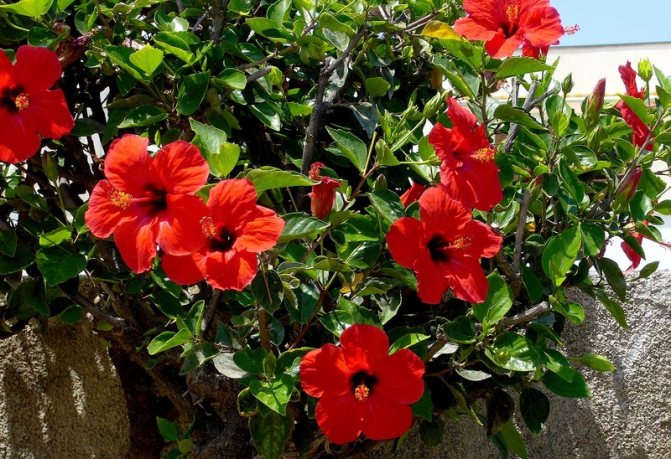
The Chinese rose is one of the representatives of the common Malvaceae species in our country. The plant looks attractive at any stage of development. During dormancy, it often attracts the attention of many people with its crown.
Since ancient times, the Chinese rose has been considered the flower of death. Why nobody knows. This is not the only plant to make this unlucky list. Calla lilies, ivy, azalea are also referred to as "deadly". Beliefs say that these plants bring death to the house.
There are various signs associated with this plant. If the plant suddenly bloomed, then these were considered a sign of imminent death. The shedding of leaves promised illness and misfortune. But this is just superstition.
Why the Chinese rose is the flower of death is not clear. After all, neither its flowers, nor leaves and fruits are poisonous. This means that all beliefs have no basis. A beautiful flower in the house will always bring joy to a person.
Proper care guarantees a beautiful crown of the plant. But when yellow leaves appear on it, the general appearance of the hibiscus changes. There can be various reasons for this phenomenon. So how to care for a Chinese rose correctly?
How important is fertilization?
Let's say you studied all the above facts and were able to correctly establish the cause of the disease.And even this reason has already been eliminated - the leaves have ceased to fall. Well, now is the time for some good news: Hibiscus will grow new green mass pretty quickly. Perhaps, if the branches of the plant were too long, it was washed away to prune them to form a beautiful bush. Pruning stimulates the emergence of side shoots. This is all the more true if the plant has lost almost all of its leaves.
The Chinese rose does not like too much phosphorus. If there is an excess of it in the soil, then the plant will suffer. But it will not remain silent - it will immediately show its dissatisfaction with the yellowed leaves. If you do not pay attention to this, then the flower will die. Why? - you ask. Because it will no longer be able to consume other trace elements.
All living organisms on earth need nitrogen and the Chinese rose is no exception. Plants use it in all their life processes. But too much nitrogen fertilization can lead to a so-called fertilizer burn, which causes the tips of the leaves to darken.
Whatever fertilizer you use, if you notice dry and darkened edges of the leaves, stop applying it immediately. Further watering should be exclusively clean water. Let the plant rest for a couple of weeks. When the time comes to resume feeding, apply a solution with a lower concentration. You can find out the required concentration empirically, gradually reducing the dosage until the plant stops responding to fertilization with leaf burns.
So we examined all the most common hibiscus diseases. As you already understood, the plant responds to almost every disease by yellowing and shedding foliage. Try not to bring the rose to a critical state, take care of it correctly. And she will thank you with a dense and lush crown, as well as frequent and abundant flowering.
alebed.org
Chlorosis as a cause of wilting
Another common source of plant wilting is chlorosis, a plant disease accompanied by a disruption in the process of photosynthesis due to a lack of iron in the soil. Its symptoms are manifested in the yellowing of the tips and middle of the leaves, which does not affect the areas of contact with the stem - they remain green. The intensity of the discoloration ranges from deep sunshine to white and indicates the extent of the problem.
The early stage of the disease often does not manifest itself in any way, and the plant looks quite healthy. As iron is removed from the soil, a slowdown in flower development can be observed: a decrease in the number and intensity of shoot growth, a decrease in the number and size of leaves. During this period, there is a gradual death at the beginning of the stems, and after the death of the entire trunk.
In some cases, if there is a sufficient amount of iron in the soil, the hibiscus will still dry out. This contradiction may be associated with the same high alkali content in the soil, which is the cause of plant nutrition failure and the lack of nutrients. To restore the balance, it is recommended to water the ground with weak solutions of citric, oxalic acids, and an iron chelate composition. Rubbing the leaves with iron sulfate is effective. It is necessary to avoid feeding the hibiscus with fertilizers containing lime.
Description of the plant with a photo
Hibiscus attracted the attention of Europeans as a home flower in the early 19th century. He is one of the representatives of the Malvaceae family. At all stages of growth, the flower attracts its attention: the chic crown does not leave anyone indifferent during the dormant period, and large and bright irregularly shaped flowers delight the eye when the Chinese rose blooms.
The Chinese rose has a sufficient number of diverse representatives, currently there are about 500 variants.Plant options include annual flowers and perennial shrubs. Under natural conditions, the dimensions of hibiscus reach a height of about 20 meters, in scope they grow to 5. Therefore, hibiscus often decorates garden fences, facades and is used as a hedge. Due to its ability to withstand low temperatures, it is sufficient to cover it with plastic wrap in winter.
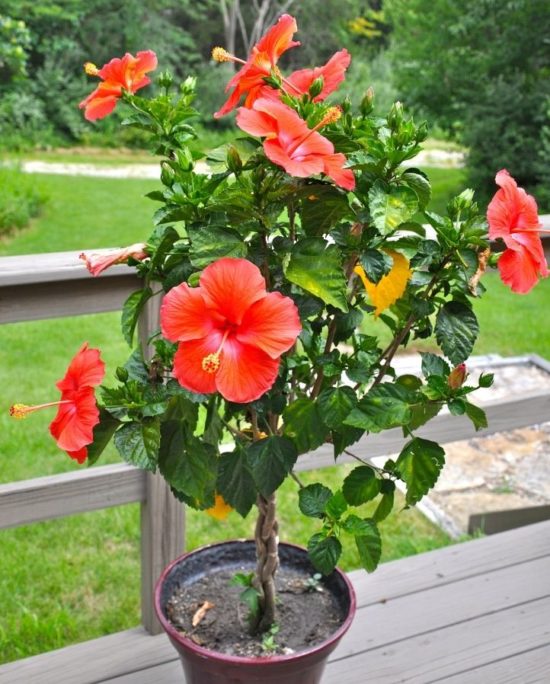

At home, the height of the Chinese rose is much less - about 2 meters. The main time for caring for a flower falls during the spring-autumn period. In winter, hibiscus is left undisturbed and only provides the necessary care and controls the condition of the leaves and soil.
Caring for the plant in spring and autumn, the main points are:
- lighting. This rose is a very light-loving plant, but it is recommended to avoid direct sunlight penetration;
- transfer. The Chinese rose grows quite quickly, so it is recommended to transplant the flower into a spacious flowerpot that matches the size of the plant. If the roots of the hibiscus in the pot are cramped, then the growth of the plant slows down significantly. Tip: When choosing soil for a Chinese rose, mix equal parts soil and peat. After transplanting, the plant must be pruned, which ensures the appearance of new shoots;
- watering. The plant likes moisture. Watering should be done frequently and abundantly. When the plant is in bloom, it is recommended to spray it with warm water. Fact: between waterings, the soil must have time to dry. In winter, they reduce the number of irrigations, but do not allow the land to dry out. Due to the dry air, it is recommended to spray the plant more often;
- temperature regime. In summer, an acceptable room temperature for the development of hibiscus is determined by a value not higher than 30 degrees. In winter, the plant is dormant and does not release shoots, so the flower can be moved to a cool place where the air temperature does not drop below 10-15 degrees Celsius.
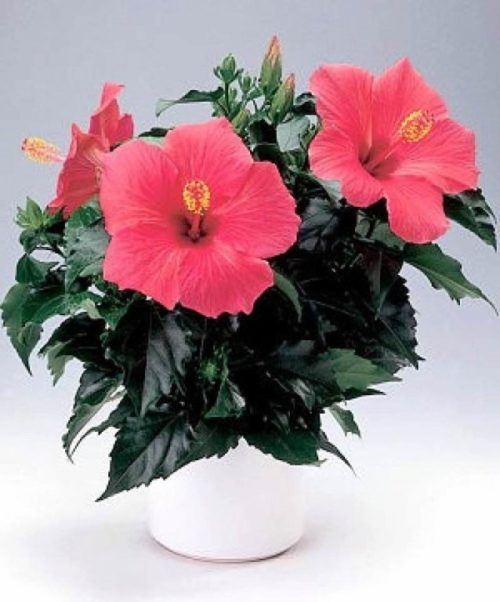

Wrong flower pot
All growers know that it is necessary to choose the right container for the plant. It determines how the hibiscus root system will develop.
How to check if the correct container is selected? It is enough to water the flower in the morning, and in the evening you should check the condition of the earthen coma in the center of the container. The pot is small for the plant if the ground is dry. We urgently need to transplant him. A "tight" pot can also cause the leaves to turn yellow. Indeed, often plants, shedding foliage, try to reduce moisture evaporation.
The new pot shouldn't be too big. Ideally, the container is 2 cm in diameter larger than the previous one. It is necessary to transplant hibiscus using the transshipment method. This way the roots are minimally injured.
There must be drainage in the new pot. The Chinese rose is transplanted into moist soil. The first watering should occur no earlier than 3 knocks.
For a plant, the capacity can be large. This is often evidenced by the accumulated water in the sump. In this case, the roots may begin to rot and the leaves may turn yellow. Transplanting into a smaller container will also help to correct this situation.
When replanting hibiscus, pay attention to the root system. The roots affected by rot must be cut off. The place is powdered with crushed activated carbon.
This plant rarely turns yellow and leaves fall off. The Chinese rose is unpretentious. But it is necessary to take into account some of its features. How to care for a Chinese rose? The plant can lose its attractive appearance due to improper care. The reason may be errors in:
- watering;
- lighting;
- lack of nutrients;
- temperature conditions.
This is a tropical plant that does not like drafts. Therefore, it is not recommended to place a pot with a plant near air conditioners and fans. In addition, when airing the room, it is recommended to cover the hibiscus with a screen.
It is not uncommon for a Chinese rose to turn yellow and fall off the leaves due to improper lighting. With a lack of light, the rose sheds the bulk of the green mass. Leaves often turn yellow on the shaded part of the plant.
Bright lighting can also harm hibiscus. Hibiscus leaves often dry out due to sunburn.
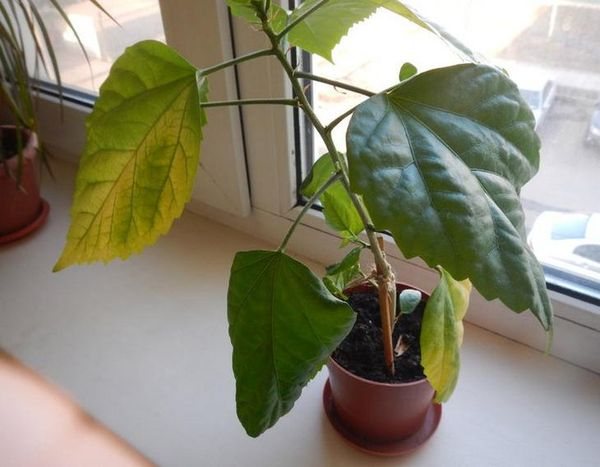

Diffused lighting is ideal. Lack of natural light can be corrected by using fluorescent lamps.
Pay attention to exactly where the leaves turn yellow and fall. The Chinese rose is a beautiful plant. If the "problematic" leaves are in the upper part of the crown, this may indicate a lack of nutrients. In this case, it is necessary to increase the concentration or frequency of feeding. But remember, everything should be limited. The plant can also suffer from an excess of fertilizers.
Top dressing of Chinese roses can be carried out in the autumn-winter period. Any fertilizer for indoor plants is suitable for this plant, the main thing is that there is a low concentration of nitrogen in the composition.
Since hibiscus is a tropical plant, the temperature regime of the environment is very important to it. In the room where hibiscus grows, the temperature should be between 18-30 ° C. At low temperatures, the Chinese indoor rose will begin to shed its green mass. Plant care must be correct and timely.
During the rest period, the ambient temperature should not fall below 15 ° C.
Caring for a Chinese indoor rose is quite simple.
Why do hibiscus leaves turn yellow and fall
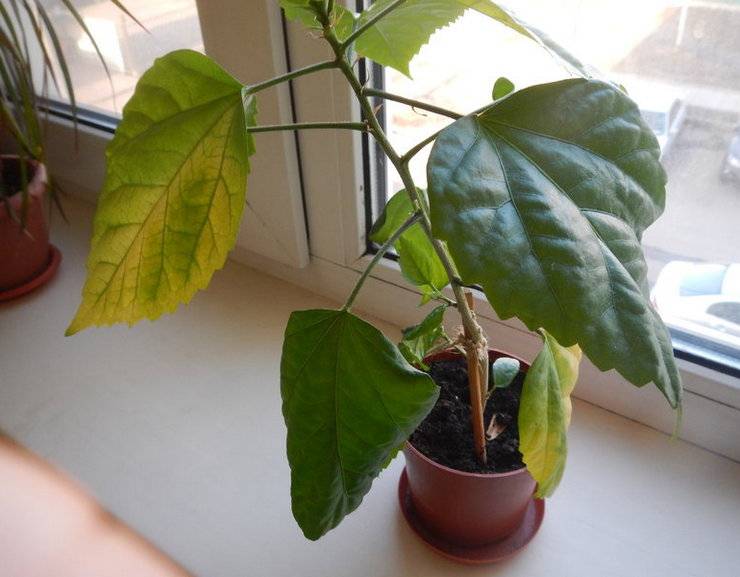

Violation of the watering regime
Hibiscus aged more than four to five years needs a lot of irrigation water every day, as required by its root system. In between waterings, the soil in the flower pot should not be wet, but always slightly damp. An excess of moisture in the soil can lead to compaction of the soil and poor air permeability, which will lead to rotting of the root part and waterlogging of the soil surface.
Stagnant water and swampy soil create favorable conditions for the appearance of harmful bacteria and various fungal diseases. Under such conditions, the root system of the plant begins to slowly die. She no longer has enough nutrients for the growth and development of the flower, so the leaves begin to turn yellow and gradually fall off. This process must be stopped at an early stage, then the hibiscus can still be saved.
Usually, a young plant cannot cope with abundant watering. It is recommended to urgently remove it from the flower container, rinse the roots, all rotten and blackened parts must be completely cut off. Then it is necessary to treat all the places of the cuts and the remaining roots with fungicides, sprinkle with the Kornevin preparation and transplant the indoor flower into a new flower container and fresh substrate. Immediately after planting, you need to spray the entire crown of a Chinese rose with a solution based on "Epin".
In an adult hibiscus, foliage often turns yellow and falls off due to a lack of moisture in the soil. Constant overdrying of the earthen coma depletes not only the root system, but leads to the wilting of the entire leaf mass. In this case, it is almost impossible to save a houseplant.
Insufficient lighting
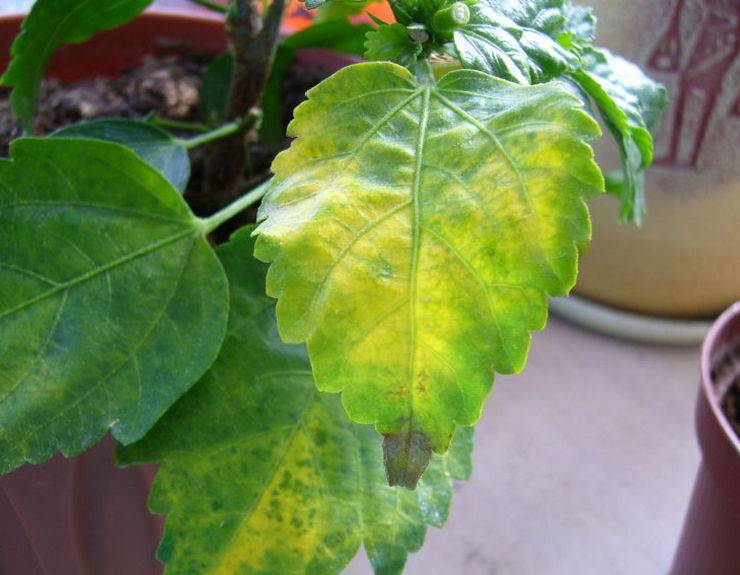

The rose can thrive in bright sunlight and grows well in shady conditions. But sharp changes in the level of illumination (for example, the transfer of hibiscus from the street to the room and vice versa) can lead to yellowing and loss of foliage.
When a flower moves to a poorly lit room, it is necessary to use fluorescent lamps and illuminate it for an additional several hours a day for some time in order to prevent the plant from falling into a stressful state.When transferring hibiscus from home to the street, it is very important not to immediately place it in direct sunlight, but to do it gradually. First, it is necessary to shade the flower at midday and protect it from sunburn.
Temperature violation
The Chinese rose prefers to be kept in warm conditions with temperatures ranging from 18 to 30 degrees Celsius. A decrease and an increase in temperature beyond these limits adversely affects the plant. It is also not recommended to allow cold drafts and sudden temperature fluctuations. In a cool room, you need to put a heater, and in a hot room, use spraying and raise the humidity level.
Lack or excess of fertilizers
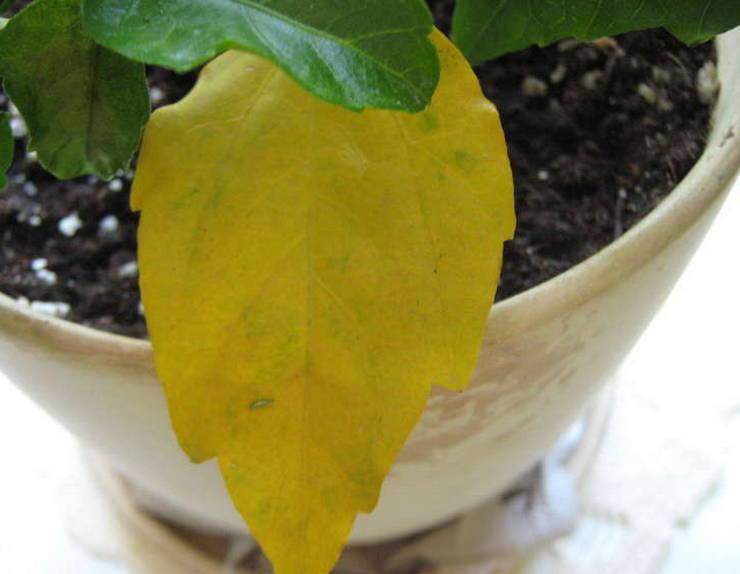

When fertilizing soil with indoor plants, you need to know exactly what nutrients are important for a given specimen. An excess or deficiency of certain substances can harm the indoor pet. For example, elements such as magnesium and potassium are very important for the development of hibiscus and should be present in increased amounts. But a large amount of nitrogen and phosphorus can cause discoloration of the leaves and lead to complete yellowing. There is even such a thing as "nitrogen burn". That is why experienced flower growers recommend choosing such dressings that contain a lot of potassium, and without nitrogen-containing and phosphate fertilizers, the Chinese rose will not disappear. The nutrient mixture should only benefit the indoor flower.
Pests
One of the most dangerous and common pests of hibiscus is the spider mite. It is almost impossible to notice its appearance at first. The leaves of a houseplant turn yellow, wither and begin to actively and in large quantities fall off and it is not immediately possible to understand that the reason is in the appearance of a pest. Only after a while, with the naked eye, you can see small black dots (with barely noticeable movement) on the thin threads of the cobweb.
There is no way to do without the help of various chemicals. Specialized retail chains for gardeners and florists offer preparations such as Fitoverm, Aktara, Aktellik to combat spider mites. With their help, the crown of the shrub and the entire plant as a whole are processed.
The appearance of the disease - chlorosis
This disease is capable of completely destroying the plant in a short time. First, the leaves die, and then gradually the shoots and the whole flower. Hibiscus suffers from chlorosis when the soil is moistened with hard irrigation water, with a large amount of alkali in the soil, with an insufficient amount of fertilizers and dressings, and also with a lack of iron. You can save an indoor flower by transplanting it into a new soil mixture and adding fertilizers containing iron into it.
Natural causes
Some indoor plant lovers begin to panic, even if one or two leaves have fallen from the hibiscus, or they have turned a little yellow. This happens when the hibiscus is actively developing, it has many new leaves, and the old ones die off. There is nothing wrong with this process, natural changes take place in living nature.
Leaf pests
Hibiscus is distinguished by excellent health and high resistance to diseases. A common reason for the development of violations of its development are pests obtained during the contact of a rose with other representatives of the fauna. A common source of wilting is infection:
- whiteflies;
- spider mite;
- aphids;
- gall midge, etc.
Symptoms of whitefly damage are yellowing and sticky coating on the leaves. The advanced stage is characterized by the development of pale yellow larvae at the base of the leaf. To eliminate the pathology, it is recommended to treat the affected areas with a solution of potassium soap.
The appearance of a spider web, accompanied by yellow large dots and dry leaves, indicates an infestation with a spider mite.For treatment, it is recommended to treat the lesions with soapy water or mineral oil. A feature of the product is the enveloping of the sheet with a thin film that does not interfere with gas exchange, but protects it from the action of a tick.
The swelling and stickiness of young buds indicates the defeat of the hibiscus by aphids. For the prevention and treatment of the plant, it is recommended to periodically process it with soapy water.
The result of damage to the flower by scutes and false scutes is the appearance of characteristic tubercles of various shades: from gray to brown. At the initial stage of the disease, they are carefully removed with tweezers, after which the infected areas are treated with mineral oil. For the treatment of volumetric lesions, the use of an insecticide is recommended.
A characteristic feature of gray rot is the thinning of the stems and leaf fall. To prevent the disease, when planting hibiscus, it is necessary to process the sprouts with "Rovral" and try to place them away from each other.
The result of the activity of gall midge is yellowing and premature dropping of unblown buds. To prevent the further spread of the pest, you must immediately remove the deformed bud and fertilize the soil with a substance from ground pests.
Florist tips
To avoid the appearance of yellow leaves in the Chinese rose, you need to use small tips:
- Watering is moderate;
- To process foliage with special means;
- Do not forget about feeding;
- Limit the abundance of sunlight.
On a note. It is sometimes useful, especially before flowering, to pamper the rose with a sugar solution. An excellent result is obtained by feeding hibiscus with activated carbon.
Finding the problem in time, understanding its cause and taking the necessary measures, you can save your favorite plant. Well-coordinated actions and good advice will allow you to enjoy the wondrous beauty of the Chinese rose for a long time.
The Chinese rose, or hibiscus, is not uncommon in the range of most flower growers. The flower does not require much grooming. However, there are situations when the leaves of a Chinese rose turn yellow and fall.
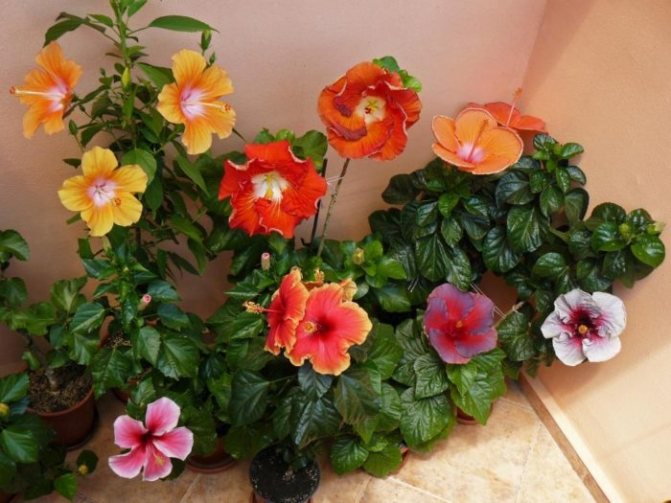

Malnutrition
Fertilizer abuse is a common cause of the wilting of the Chinese rose. This plant does not tolerate the thoughtless use of pesticidal dressings. The result of excessive enthusiasm for them is the yellowing of the leaves. To eliminate the risk of flower death, it is necessary to use one form of these fertilizers in minimal quantities. Feeding with pesticides should be done either in the early morning or in the evening before sunset.
Similarly, hibiscus does not tolerate an excess of phosphate fertilizers. Externally, excessive use of these fertilizers leads to yellowing of the leaves, internally - "blocking" the flower's nutrition system, which does not allow it to consume other nutrients.
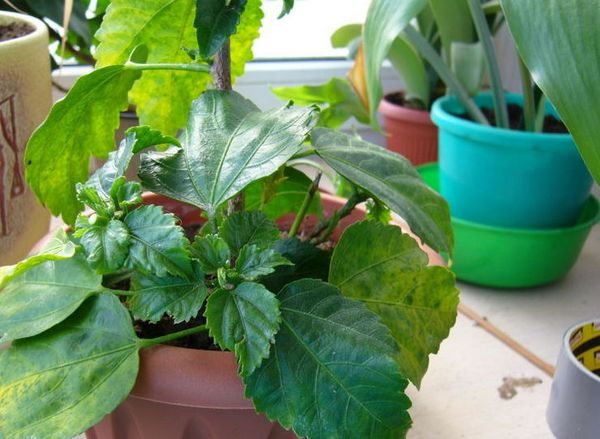

You should be very careful about feeding the crop with nitrogen fertilizers. Incorrect addition of the additive can lead to leaf burns and gradual death of the entire plant. The observation of characteristic brown spots indicates oversaturation of the soil with nitrogen and the need for therapeutic therapy. It is necessary to stop any feeding and water the rose only with clean water for 2 weeks. As the plant recovers from the crisis, it is necessary to gradually introduce this element in small quantities until the optimal dose for a particular plant is selected.
For feeding hibiscus at home, it is effective to use a sugar solution. To prepare it, you must mix 0.5 tsp. granulated sugar and a glass of water. The resulting product is poured over the soil as it gets wet. To treat a plant from sunburn, it is recommended to wipe the affected leaf with this solution.
The Chinese rose is one of the non-capricious plants that do not require special care.An essential factor in maintaining it in a healthy state is compliance with the rules of maintenance, reorganization, and feeding. By following these simple principles, the problem of flower wilting can be easily prevented.
Why does hibiscus (Chinese rose) turn yellow?
Yellow hibiscus leaves - a signal to the owner that the plant is unhappy with something, that it is under stress. What is the cause of stress can be difficult to figure out, because hibiscus reacts to any cause in the same way - with yellowing and falling leaves. And, nevertheless, having information about the likely causes of stress and analyzing your case, you can most likely determine why your hibiscus turns yellow.
Insufficient watering.
In the hot season, hibiscus needs constant watering. The earth ball should not dry out, and if you need to water the hibiscus every day to avoid this, water it. In addition, daily spraying of the leaves in summer and weekly in winter is necessary, since the presence of heating devices in the room reduces the air humidity required for the plant. For both irrigation and spraying, use only settled water.
Excessive watering.
During cooler seasons, make sure that the potted soil does not turn into a liquid mess. Hibiscus loves water, but does not tolerate cold swamps in the root area.
Abundant sun.
Direct sunlight can cause not only yellowness of the leaves, but also the appearance of burns on them, so let the plant get its norm of harmless morning rays, but it is better to shade it from the scorching midday sun.
Lack of light.
Hibiscus, like any plant, produces chlorophyll only when exposed to light. If there is not enough light, it will turn yellow and shed the leaves until a few leaves remain, for which the meager amount of chlorophyll produced by the plant under insufficient light is sufficient.
Temperature too low or too high.
The Chinese rose is a tropical plant, therefore it does not tolerate hypothermia. And overheating is not good for her. A comfortable temperature for her is + 18 + 30. When it is cold or hot, it reacts by shedding yellowed leaves.
Pests.
Hibiscus suffers greatly at home from spider mites. If you find traces of their vital activity on your plant (dirty spots on withered leaves, thin cobwebs between leaves), take a magnifying glass and take a closer look: small ticks look like crabs. Getting rid of them is not easy, so do not add insecticide to the plant or spray it with soapy water several times a day. It will take a very, very long time to restore a plant destroyed by ticks.
Chlorosis of the soil.
The soil in which hibiscus grows can sometimes become too acidic or too alkaline. This usually comes from watering the plant with unfiltered hard tap water. The leaves in such cases do not turn yellow completely, but in patches. Sometimes a lack or excess of certain nutrients in the soil leads to the yellowness of the leaves. In such cases, the necessary fertilizers are applied or the acidity of the soil is corrected.
Fertilizers.
If you use pesticides more often, the leaves turn yellow too, so try to treat the plant with the same pesticide at the same (minimum) consistency in the early morning or evening. Phosphate fertilizers added to the irrigation water increase the flowering of hibiscus. But do not use high-phosphate fertilizers in the care of your hibiscus: this will kill the plant. When feeding a plant with nitrogen fertilizers, show a sense of proportion. As soon as you notice that the leaves have brown edges, know that this is a nitrogen burn, which means that you need to stop adding nitrogen fertilizers to the water for irrigation for two weeks.When you start fertilizing again, reduce the dose in half and increase it gradually, observing the leaves, until you find the optimal dose.
We have considered all the reasons from which hibiscus turns yellow. You just have to use the method of observation and experiment to reveal your own. If you are not mistaken and have time to save the plant, you can enjoy its dense foliage and lush flowering for a long time.
Pests and diseases
Everyone knows that diseases and pests negatively affect the state of the plant. They gradually "eat" the hibiscus. Therefore, all growers know that it is necessary to fight pests and diseases immediately. Otherwise, you can lose the plant.
If the leaves turn yellow and fall on a Chinese rose, and there are no errors in care, the fact of the disease should be excluded.
Definition
Hibiscus disease is a variety of deviations in its growth and development, as well as in violation of its decorative appearance. Absolutely different parts of the plant can be affected, depending on the type of disease and the cause of its development.
Types of ailments
There are several diseases that affect different parts of the flower:
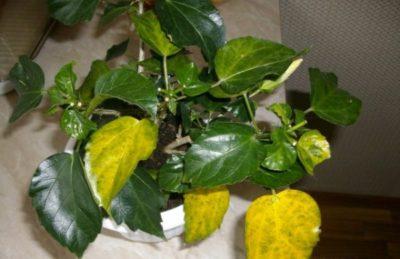

Rust. With this ailment, the shoots of the plant are bent and thickened. With the onset of spring, orange dust forms on the stems at the blossoming buds and at the root collar.- Powdery mildew. This is a fungal disease in which a powdery coating forms on young leaves, shoots and buds. In addition, the affected parts of the flower thicken and bend.
- Starting in the second half of summer, a dark brown spot is formed on the leaves, which takes on various sizes. The leaf plate turns brown, and the foliage falls off.
- Bacterial cancer. On the root collar and roots of the Chinese rose, growths of different sizes are formed. At first they are barely noticeable, but then their size reaches several centimeters in diameter. The growths are characterized by an uneven tuberous surface. They are made of soft fabric. Initially, their color is white, and then brown.
The main difference is that parasites on leaves or stems leave certain traces of their vital activity, for example, mucus, sticky plaque. But diseases, as a rule, manifest themselves in the form of spotting on the leaves, rot of the stems. In addition, it is enough just to carefully examine the flower and understand if there is any of the pests on it.
Chlorosis
Viral diseases negatively affect the condition of the plant. A sign of the disease is not only yellowing of the leaves. Spots appear on their surface. In plants affected by chlorosis, the leaves turn yellow, while the veins remain in their natural green color.
This disease manifests itself with improper soil acidity. Chlorosis can partially affect the plant. Yellowed leaves, underdeveloped roots and tops often die off.
Using complex fertilizers, transplanting the plant into new soil, you can overcome this disease.
As a preventive safety measure, flower growers do not recommend watering the plant with hard tap water. It increases the acidity of the soil.
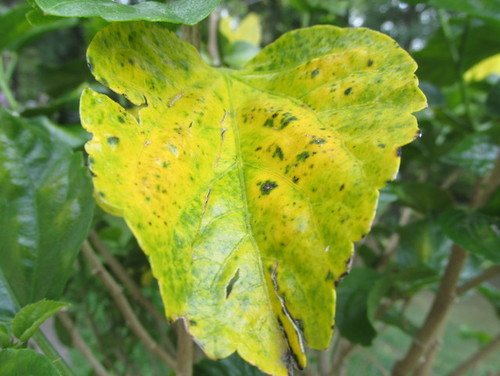

Spider mite
Spider mites can also cause the leaves to turn yellow. This pest can only be detected with a magnifying glass. Visually, you can see a weightless cobweb on the buds and leaves.
Pest control can only be done with insecticides. Some growers use a steep soap solution. It is washed by the leaves. After that, the plant must be sent to the shower, and the soil must be covered with a film.
The plant often takes a long time to recover.
Gardeners recommend treating plants with insecticides 2 times a year to prevent the spread of the tick. Plants are treated 3 times every 4 days.
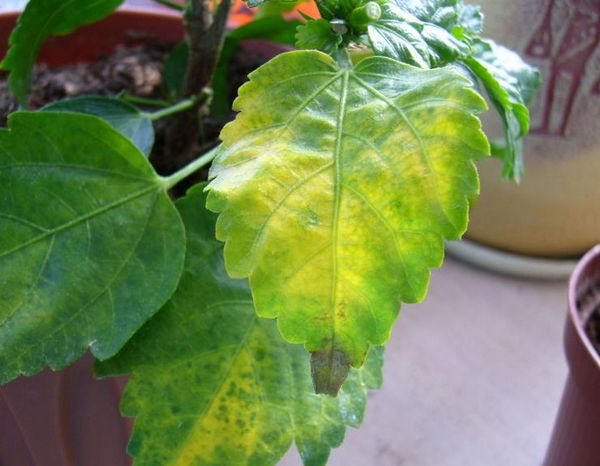

The ideal conditions for the spread of spider mites is a room with dry air. In this case, use humidifiers. You can leave containers with water near the plant.Spraying from a spray bottle has a beneficial effect on hibiscus.
Diseases and pests
When a hibiscus is infected with viruses, the leaves not only turn yellow - spots appear on them. To prevent the Chinese rose from dying, treatment must be started immediately. In the absence of errors in the care and the presence of yellowed leaves, the fact of plant disease is excluded.
Chlorosis
This virus is the most common disease. With it, the leaf of the plant turns yellow, and the veins retain their natural color. Chlorosis is a consequence of soil with disturbed acidity levels. The situation can be corrected by a complex of mineral fertilizers, by transplanting a plant into fresh soil. Tip: in order to avoid the disease, it is not recommended to water the hibiscus with hard water. It contributes to the acidification of the earth.
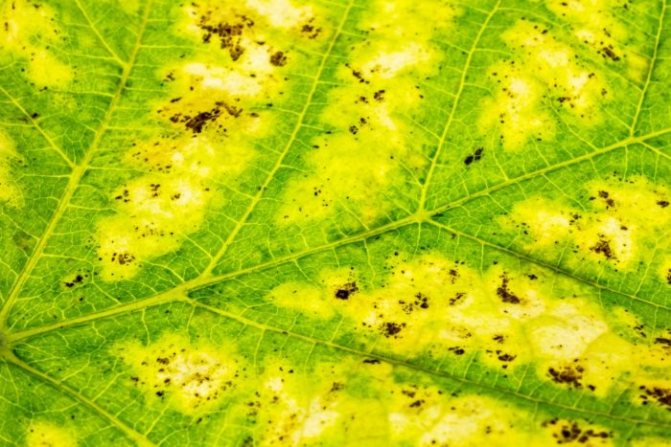

Spider mite
Yellow sheets can indicate the presence of a spider mite, it can only be seen when using magnifying devices. Dry air is the basis for why spider mites appear. To prevent its appearance, use humidifiers and do prevention using insecticides a couple of times a year. To save a sick hibiscus, it is recommended to wash the leaves with soapy water. Spraying regularly with water will reduce the chance of spider mites.


Yellowed leaves always indicate some kind of disease. It is important to quickly find the reason why the leaves of the Chinese rose turn yellow and fall off. This will speed up the healing process and lead to a speedy recovery of the Chinese rose.
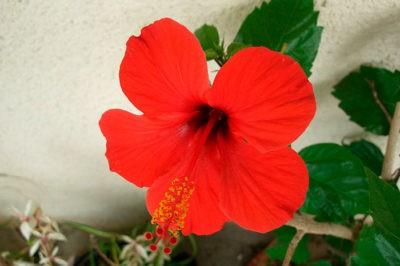

Each of the growers, sooner or later, is faced with various plant diseases. One such problem is yellowing of the leaves.
In our article, we will talk about why the leaves turn yellow, and how to restore health to the flower. And we will not tell about all indoor flowers, but about one specific one - the Chinese rose.
What kind of flower is it, why does it shed its buds and what are the features of caring for this plant, we will talk further.
Flowering problems
Although the beauty of hibiscus is noteworthy, it is worth dwelling on the common troubles when growing it. The Chinese rose is not unique and gets sick from time to time. If, even with proper care, it dries, turns yellow and leaves crumble from it, it is important to understand the reason and take appropriate measures.
Leaf fall can occur in connection with the preparation of the plant for the dormant period, which is quite acceptable. After flowering, rest is required to recuperate for the next budding and dissolution. If the flower does not stop shedding its leaves, and this happens regularly, most likely the matter is in the conditions of detention. Yellowing is also a warning sign that the rose is stressed.
| Cause | Remedies |
| Excess sun rays. Can cause burns. The hibiscus should be kept in a place where there is diffused light, without its direct rays. Variegated varieties are especially dependent on this condition. | Move the pot to another place or shade the plant |
| Lack of moisture. Leads to overdrying of the earth. Sometimes hibiscus is thirsty even with systematic watering in the morning and evening. This problem is especially relevant in the summer. Perhaps this is due to the too small size of the pot: for an adult plant, the capacity is selected in accordance with the root system. To understand whether the hibiscus feels comfortable, the soil in which the plant is located is moistened in the morning, and the degree of drying of the soil is checked in the evening. If it is dry in the center, then there is not enough space. In a situation like this, the hibiscus will try to reduce moisture evaporation by dropping leaves. | Transplanting into a larger pot is required using the transhipment method. Water only after 3 days |
| Excess moisture. Yellowing occurs if watered frequently and abundantly. This often happens, as the plant is hygrophilous and eagerly absorbs water, especially on hot days.Water accumulating in the sump causes damage. In both cases, the roots begin to rot, which negatively affects the ground part. | It is necessary to adjust the humidification mode. The plant is completely removed from the soil, the roots are examined for rot and removed, if any. Then they are transplanted into a new container of smaller volume. There must be a drainage layer at the bottom. |
| Spider mite. This pest is always on the plant, but it is activated only in a microclimate favorable for it, that is, when the air in the room is dry. In addition to yellowness, cobwebs and whitish bloom are observed on the plant. | The flower is rinsed under a warm shower if it is winter. In the summer, they are systematically sprayed with soapy water and taken out into the fresh air. After that, they are treated with systemic insecticides - 3-4 days in a row. Suitable drugs: Actellik, Fufan, Agravertin |
| Lack of nutrients. During the period of active growth (spring and summer), top dressing is applied regularly. Liquid complex formulations are used for non-flowering representatives. Those that contain large amounts of phosphorus are not suitable: it is harmful to flowers. It is recommended to fertilize in cloudy weather and after the next watering | The optimal ratio of mineral components in the composition (phosphorus, nitrogen and potassium) is 3: 9: 12 or 3:11:12. According to these indicators, a suitable fertilizer is selected. |
| Chlorosis. If the leaves turn yellow, but the veins remain the same green color, then this is evidence of this disease. It occurs due to the plant's inability to produce chlorophyll. This happens when using water from a water supply for irrigation, | The lack of trace elements is eliminated by introducing complex additives. Irrigation water is pre-defended |
| The lower leaves crumble, and the new ones grow yellow - the irrigation water is oversaturated with chlorine and calcium. This is possible with a lack of nitrogen or iron. | They act as in the previous case: they additionally add special prophylactic agents for chlorosis |
It is vitally important for the plant to be in comfortable conditions, otherwise there will be one reaction - the dropping of leaves and subsequent death. The prerequisites for healthy growth and development are as follows:
- Being in a bright place, but not in direct sunlight.
- Lack of drafts.
- Removal to fresh air in summer.
- Moderate watering: once every 4–5 days. There should be no water remaining in the pan.
- Systematic spraying and moisturizing of the surrounding area throughout the summer and until late autumn.
- Location sufficiently remote from heating devices.
- Application of liquid fertilizers in the summer season.
- Pruning is required at the end of winter for abundant branching.
The optimum temperature regime from spring to early autumn is 17–23 ° C. In October, the degree is lowered to 15-18 ° C, and in winter - 13-15 ° C in the presence of artificial lighting. When the temperature drops to 10 ° C, there is a high risk of yellowing and leaf fall.
When applying fertilizers, you should be careful to find the optimal middle. Both a deficiency and an overabundance entail a negative reaction in the plant. With nitrogen starvation, only the veins turn yellow, with potassium starvation, the entire plate is completely. Too many of these elements cause darkening of the tips of the sheets, which is a consequence of a burn.
Any feeding is stopped immediately as soon as the first alarming symptoms began to appear.
Further steps to resuscitate the flower:
- 1. Hibiscus is moistened with exceptionally clean and settled water.
- 2. The plant is left alone for at least two weeks. This time is quite enough for rest and recovery.
- 3. At the next application of fertilizers, the concentration is reduced, determining the acceptable dosage by samples. Each time, the reaction of the hibiscus is observed. They stop at the one when the burns stop showing through.
If the cause of disruptions in the health of hibiscus is established and eliminated, leaf fall immediately stops and the growth of green mass occurs in an enhanced mode. It is recommended during this period to make a rejuvenating pruning of strongly regrown branches. Then the bush will grow thicker and even more beautiful.
Many novice flower growers are faced with the fact that the Chinese rose does not bloom. What to do? Solving problems is easy. It is necessary to transplant the plant, cut off old branches and put the pot in a well-lit place. This will stimulate the plant, new shoots will appear, on which strong buds will appear in the future. Some hibiscus varieties can only flower on young branches. Therefore, in order to enjoy flowering for a long time, it is necessary to periodically cut off old branches.
Hibiscus also may not bloom if it is in an overly warm room. Therefore, with the beginning of the heating season, it is recommended to immediately take the plant to a cool room. Believe me, you will soon notice the first buds.
Hibiscus leaves turn yellow: causes, effective treatment
Not sure what to do when hibiscus leaves turn yellow and fall off? Expert advice on how to diagnose the problem and effectively fix it will help you more than ever.
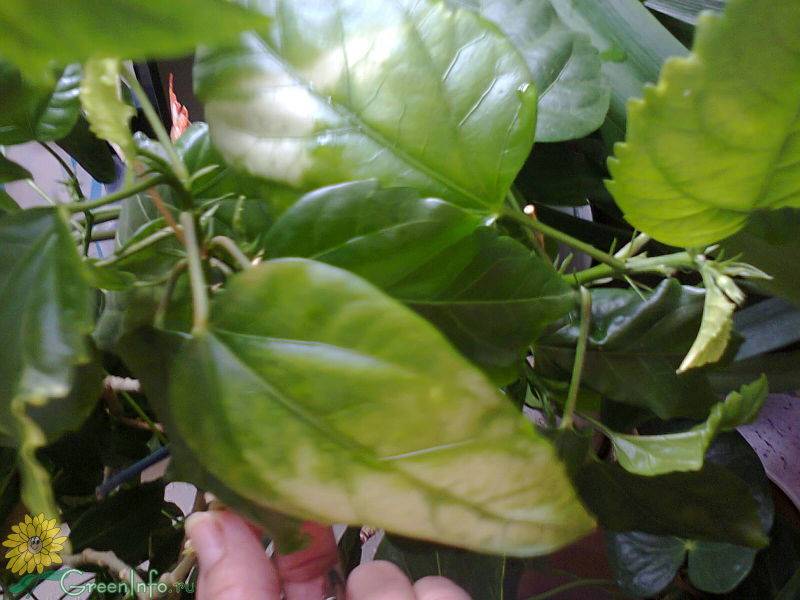

The hibiscus stands by the window. His leaves turn yellow. The leaf plate first changes color - brightens, then turns yellow. Hibiscus leaf falls... Reason: a large amount of direct sunlight, which leads to leaf burns. Hibiscus needs diffused light, especially variegated varieties, but direct sunlight is detrimental to its leaves. Control measures: shade the plant.
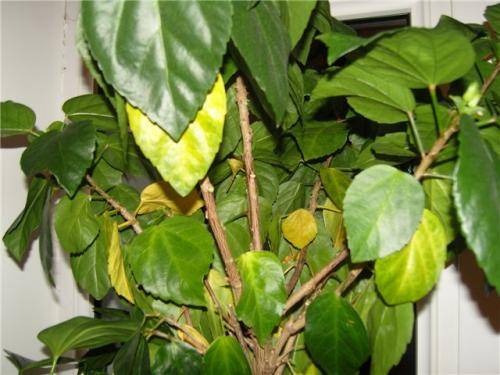

Why do hibiscus leaves turn yellow and fall off? This is due to the drying out of the earthen coma in the pot. Even if you regularly water the plant (in the morning or in the evening every 2 days), especially in summer, the hibiscus may not have enough moisture due to the small volume of the pot. An adult plant is planted in a pot, the diameter of which is fully consistent with the size of the root system. How do you know if a pot is suitable for hibiscus? To do this, water the plant in the morning. By evening, you need to check if the earth in the middle of the pot is dry. If so, then the bowl is small for hibiscus. His leaves will turn yellow, as the plant tries to reduce the evaporation of moisture from the surface of the foliage, shedding excess leaves. In this case, the plant is transplanted into a new container, the size of which is larger than the previous one, by transshipment, without violating the integrity of the earthen coma. Watering is carried out only on the third day after transshipment, taking into account the fact that the transplant was carried out in moist soil.
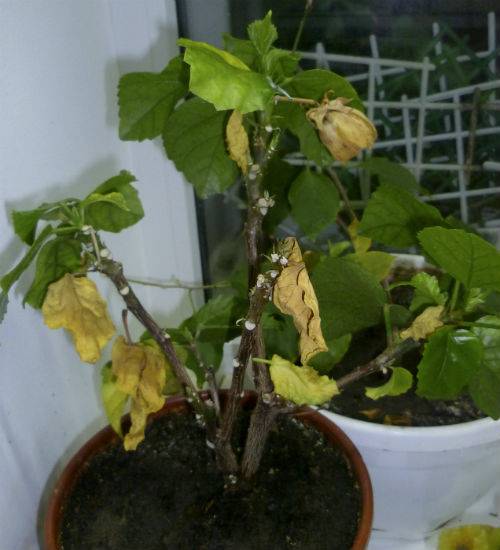

Hibiscus leaves turn yellow if it gets too much moisture. Several factors are visible here:
- overflow of plants. Although hibiscus is very water-consuming, especially on hot days, due to its ability to accumulate moisture in the roots, it is not difficult to pour over. Harmful to the plant and the accumulation of liquid in the pan. In both the first and second cases, the root system of the plant begins to rot, which is reflected in the leaves of the hibiscus. They turn yellow and fall off. Control measures: moderate watering, make sure that water does not accumulate in the pan. Remove the plant from the pot along with the earthy clod. Examine the roots for rot. If there are any, they are removed, and the hibiscus is transplanted into a pot of smaller volume than the previous one. Good drainage is essential;
- large pot volume. In this case, a large amount of moisture accumulates in the soil, which the hibiscus root system is not able to absorb. As a result, the roots rot and the leaves of the hibiscus turn yellow. In this case, you need to reduce the size of the pot and normalize watering.
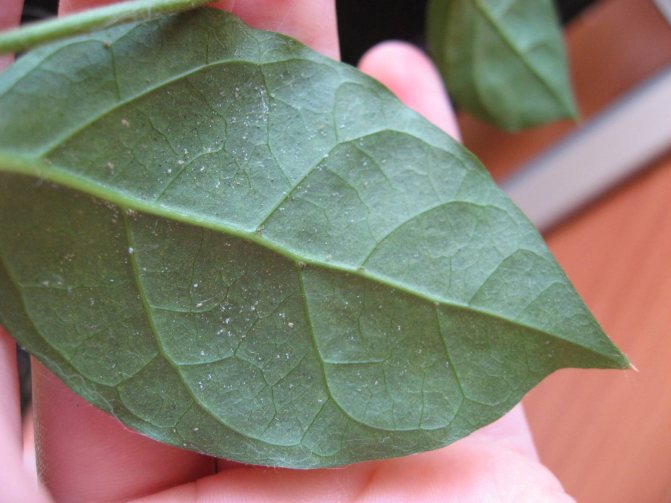

If indoor hibiscus is grown in dry air, its leaves turn yellow due to spider mite damage. This parasite is almost always present on the plant. However, its development stimulates dry indoor air.In this case, in addition to yellowed leaves, a barely noticeable cobweb and white bloom are present on the plant. In this case, arrange a warm shower for the plant. If this summer period favorably affects the flow of warm fresh air, regular spraying. For winter, an infrequent warm shower is suitable. Additionally, hibiscus is treated with insecticides at intervals of 4 days 3 times. These are drugs Agravertiv, Fufan, Actllik.
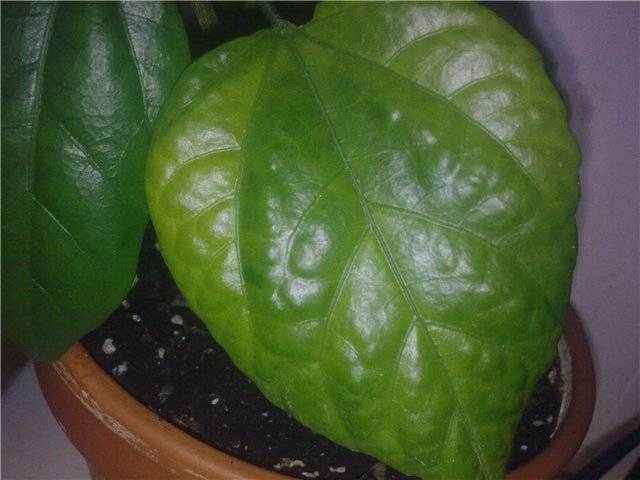

Why do the leaves of indoor hibiscus turn yellow? The leaves of hibiscus can turn yellow from a lack of nutrients. It is often necessary to feed the plant during intensive growth and development (spring, summer). But for this, liquid complex fertilizers are used for non-flowering plants. Fertilizer for hibiscus should not contain a lot of phosphorus, which is harmful to the flower. Top dressing is best applied on cloudy days, when the earthen lump in the pot is well saturated with water. The optimal chemical composition of fertilizer for hibiscus: N: P: K (nitrogen, phosphorus, potassium) 9: 3: 13 or 10: 4: 12 or 12: 4: 18. Fertilizing with the following chemical composition N: P: K 16:20:27 or 15:21:25 may harm the plant. Hibiscus leaves can also turn yellow from an excess of phosphorus.
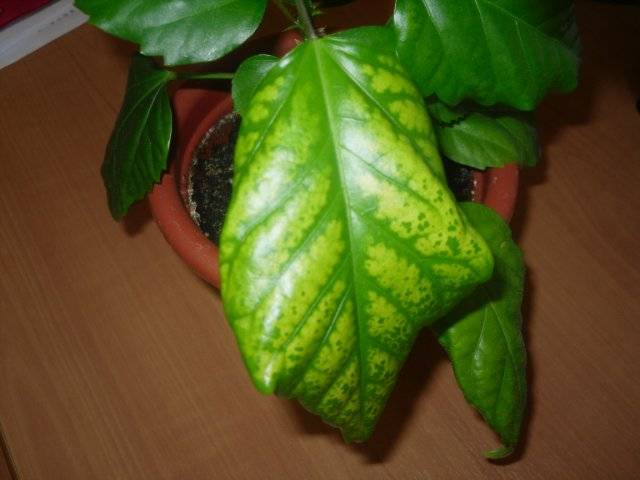

The leaf of the hibiscus turned yellow, but the veins remained bright green in color. Hibiscus has chlorosis, that is, the leaf does not produce enough chloroform, so the hibiscus leaves turn yellow. Control measures: to compensate for the lack of micronutrients. This is magnesium, which in small amounts is included in complex fertilizers. Chlorosis of hibiscus leaves occurs as a result of watering the plant with unsettled, untreated water.
How to prune hibiscus branches
Pruning a Chinese rose at home does more than stimulate flowering. Such manipulations allow you to form a beautiful crown.
Before the first pruning, you need to decide: do you want to get a beautiful tree or a lush bush? Pruning is done in early spring, until the plant begins to actively grow. Some growers prune the branches in the fall after flowering.
Remember to cut only those branches that do not have buds.
This manipulation is performed with sharp scissors. Be sure to remove all lignified and dry branches. To get a lush bush, each branch must be cut to 1/3 of its length.
Hibiscus care
Often, hibiscus diseases can cause improper care of it. This reason is the most common. Even damage by pests and fungi can cause less significant damage to the flower than the owner himself.
For a comfortable life, a Chinese rose requires a certain condition. A home flower should be installed near the window, in the brightest place. In the shade, the rose will refuse to bloom. In warm weather, for a rose, you need to open a window for a full flow of fresh air. However, all other windows are closed so that the plant does not end up in a draft.
Why do the leaves turn yellow?
It is better to water the indoor rosebush with warm water and not earlier than the soil dries out a couple of centimeters. Hibiscus needs high humidity. In the summer heat, it should be sprayed. It should be noted that when the winter is very cold, the air humidity and its quality in the room drop sharply due to the increased work of the heating system. During this period, the Chinese rose needs spraying and systematic airing.
Do not forget to feed the hibiscus with complex fertilizers from spring to early autumn. In the winter period, feeding is not carried out. Exceptions are cases when a rose, brought to the house for the winter, begins to form a flower bud. In this case, fertilization is allowed, but in small doses.
Note: Like all garden roses, indoor roses also need pruning. The best period for the procedure is spring.
Why is the plant affected by ailments?
The genus Hibiscus is part of the Malvov family. There are more than 200 species.In the natural environment, flowers grow in countries with tropical climates: India, China, Asia. For indoor cultivation, only Chinese hibiscus or Chinese rose is suitable.
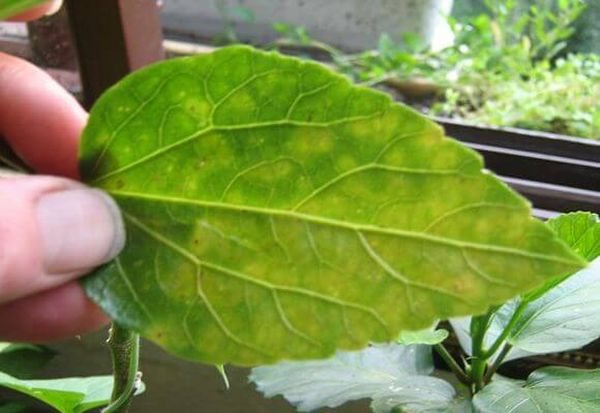

Hibiscus is not particularly capricious. The growth of the rose is quite intense - 6 months after planting the cuttings, budding is already observed. It blooms with bell-shaped inflorescences, of different colors: white, red, yellow, pink. In the natural environment, there are much more colors.
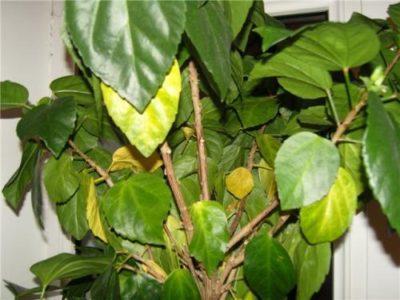

Drying out. The main reason for the drying up of the Chinese rose is the lack of modern watering. It is also the plant's reaction to a change of location. The leaves will dry up near the frozen flower. You just need to give him time to recover and warm up.- Withering. The main reason for the wilting of the tips of the leaves is a deficiency of phosphorus, nitrogen, and the absence of hibiscus complementary foods. An increased temperature in the room and a decrease in humidity to low levels can affect the general wilting of the leaves and the entire flower.
- Rolling leaves. If the Chinese rose began to twist the leaves into a tube, then this is a symptom of pest damage. The most dangerous pests for hibiscus are aphids, whiteflies and spider mites.
- Falling off (about why the buds and leaves of a Chinese rose fall off and what to do about it, you can find out here). Falling leaves is a reaction to low humidity, lack of spraying, a sharp change in lighting, drafts and other types of stress for a rose.
- Yellowing of the crown. The yellowing of the leaf plate causes several reasons:
- pests;
root diseases;
- chlorosis of leaves;
- poor air humidification in the room.
- Lack of flowering. There are many reasons that affect the lack of flowering. The most basic is the excess nitrogen fertilization, especially when the plant looks healthy and is abundantly covered with leaves. The following reasons can also affect the lack of flowering:
- bad light;
- insufficient moisture;
- during wintering, the Chinese rose is in a room that is too warm.
ATTENTION: If yellowing and falling leaves are observed at the same time, then this is due to waterlogging of the soil, stress and low humidity in the room.
Read about why the leaves and buds of the Chinese rose turn yellow and fall and what to do to treat it, read our material.
Why does this happen to a houseplant and how is it treated?
Improper watering
If the air temperature in the room is high, the flower needs abundant watering. If it is too hot and windy, water it daily, and sometimes even twice a day. A good way in this case is a drip irrigation system.
Chinese rose can suffer from too much watering.especially in the dark and cool seasons.
Unsuitable temperature
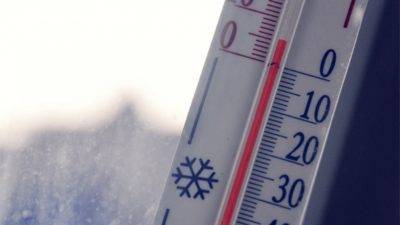

If the hibiscus does not have enough moisture in the heat, the flower reduces the need for water and sheds its leaves. In hot weather, the plant needs a lot of water to feed all the leaves.
Also cold can cause illness... To make the flower comfortable, the air temperature should be between 18 and 30 degrees, because this is a tropical plant. Therefore, if the room is cold, for example, in winter, the hibiscus is close to the window, it can react to the temperature by dropping leaves, which is why you need to monitor a comfortable temperature.
Incorrect lighting
The Chinese rose loves warmth, but should not be exposed to direct sunlight. Excess ultraviolet radiation can cause burns, which provokes the yellowness of the leaves, the appearance of white spots on them and massive abscission. On the contrary, too little light will also cause a number of problems.
Light is the source of life for hibiscus, and if there is little light, the plant will shed its leavesuntil there are only a few left, as fewer leaves means less lighting is needed.
Dry air
Being in a room with dry air, hibiscus may not bloom, because the flower loves high humidity.Also, excessive dryness is dangerous for diseases.
Unsuitable soil
Violation of the acidity of the soil can lead to chlorosis. Sometimes the leaf can turn yellow only where the disease began to develop. If the yellowness does not spread to the rest of the leaves, the flower may be lacking in nutrients.
Lack of fertilizer
Top dressing is essential for proper growth and flowering of hibiscus. So, a gradual increase in the amount of phosphorus with each watering provokes flowering. However, too much of it leads to the death of the plant.
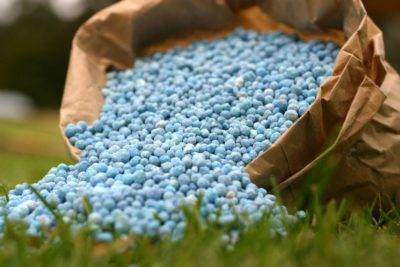

Hibiscus needs nitrogen, like all plants. It uses nitrogen in all metabolic processes. But here, too, there is a nuance - an excessive amount of nitrogen causes a nitrogen burn. Therefore, a medium amount of nitrogen is ideal for hibiscus.
Deficiencies in zinc, manganese, magnesium and iron also cause the leaves to turn yellow.... Zinc deficiency is mainly caused by disturbances in the acidity of the soil. To eliminate these problems, it is necessary to fertilize or transplant the plant with partial or complete replacement of the soil mixture.
Potassium deficiency can be corrected by adding wood ash.
Frequent change of location
The Chinese rose does not respond well to a change in location - due to the movement, the buds fall off and flowering stops, and sometimes serious diseases. Therefore, when choosing where to put the plant, take into account all factors in advance so that you do not have to expose it to stress.
Pests
First of all, these are spider mites. Usually they cannot be seen with the naked eye, but you can learn about them by the footprints - spots on the leaves. On the back of the leaf, you can see traces of the plant sap sucking up by the mites, and mites leave a cobweb between the leaves and at the top of the stem.
After a tick, hibiscus takes several weeks to recover.so the problem is better prevented. To do this, use special insecticides and regularly - several times a day - spray the leaves with soapy water.
Reproduction of hibiscus
The easiest way to propagate a Chinese rose is by cuttings. You can use the shoots obtained after pruning the plant. The main thing is that the shoot must be lignified and healthy.
The stalk should be placed in a container of water until the roots appear. For stimulation, you can add a growth stimulant or activated carbon to the water.
With the appearance of roots, the sprout can be transplanted into a small pot with ordinary soil. Remember that the plant needs regular watering.
It is also advisable to build a greenhouse. It is enough to cut off the plastic transparent bottle and cover the young plant with it. Be sure to make some ventilation holes. After the appearance of the first leaf, the greenhouse can be removed.
What is yellowing?
Chinese rose, aka hibiscus, a pretty hardy plant... She stoically tolerates errors in care, but if they are not permanent. If the plant is constantly poured or not watered at all, then the plant will begin to die. His leaves will begin to turn yellow and fall off, then buds and flowers. And if you do not pay attention to this, he will die.
This is not about natural aging, but about the causes of yellowing in a young plant. When the plant loses its beauty for other reasons. Therefore, the yellowing of the leaves is a signal that something is wrong with the Chinese rose.
Instructions on what to do at home
If the bush dries
If a Chinese rose dries up, then the first thing to do is to normalize its watering. From spring to autumn, the flower needs moisture. For irrigation, use settled water at room temperature.
These products are toxic, so be sure to open a window and wear gloves and a respirator before using them.
The processing looks like this:
- First, thoroughly water the flower, and treat the stems and leaves with soapy water.
- Now you can proceed to spraying, and use several drugs in turn.
- Re-processing should be carried out in 7-10 days.
As for folk remedies, they are effective only at an early stage of infection. Popular recipes:
- Onion infusion. For 20 g of husk, 1 liter of water. Insist 5 days, spray the bush with infusion, wipe the leaves and branches.
- Infusion of garlic. Pour 2 large and chopped heads of garlic, pour 1 liter of water and leave for 5 days. Before use, dilute the infusion with water in equal proportions and spray the bush.
Hibiscus withers
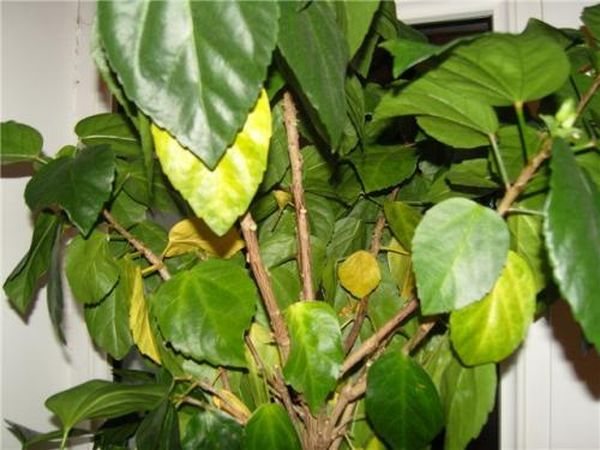

If the plant begins to wither, then it can be very difficult to cure it. But you can try if you use the following recommendations:
- Remove all dried parts of the plant, slightly touching healthy parts of the plant.
- Treat the rose with antifungal drugs: Fundazol, Topsin, Dezavid. You can use a folk remedy - Trichopolum solution (2 tablets per 1 liter of water).
- For additional stimulation of the rose, treat it with such preparations: Epin, Zircon, Domotsvet.
IMPORTANT: If at the initial stage it was not possible to cure the hibiscus, and it still withers, then you will have to get rid of it.
Leaves curl
When working with drugs, use gloves and ventilate the room well!
Foliage falls
If the leaves began to fall off, then such parasites are to blame:
- Shield. The leaves are mechanically cleaned using a soapy lip. Next, process 0.155 Actellik solution (1-2 ml per 1 liter of water).
- Aphid. To combat it, spraying with Dirris, Fitoverm, Decis, Aktellik is used. If the lesion is strong, then repeat the treatment after 10 days.
Turns yellow
To prevent the appearance of yellowness on the leaves or get rid of it, you will need to comply with the following recommendations:
- Watering should be moderate, avoid the presence of standing water.
- No draft.
- Timely subcortex.
- Lack of direct sunlight.
- Processing of leaves with special means for prevention.
TIP: In case of a viral infection, it makes no sense to carry out treatment, the diseased flower should be immediately removed so that the rest of the plants do not become infected.
Does not bloom
If the hibiscus does not bloom in any way, it needs to be stimulated:
- To stimulate flowering, it is necessary to cut off old branches in a timely manner.
- Change the old soil to a new one.
- Place the plant in a sunny place.
- Do not forget to apply fertilizers to stimulate new shoots and buds. But to reduce nitrogen-containing compositions.
If the Chinese rose is on the verge of death, then an urgent resuscitation is needed. It includes the following procedure:
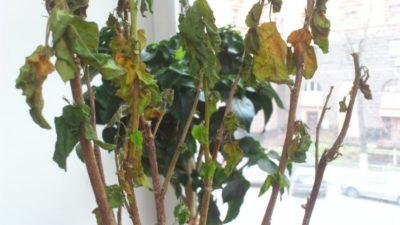

Dilute Zircon - 4 drops per 1 liter of water.- Thoroughly process the bush with the solution and pour a little under the root.
- Put a transparent bag on the crown. It will keep the high humidity. But you should not tie it. Remove the bag for airing every day.
- Place the pot in a bright place.
With high humidity and good lighting, dormant buds will awaken and the root system will begin to develop. Zircon should be treated every day, as it restores turgor.
Problems and solutions
It is impossible to confidently name the reason for the loss of an attractive plant species without analyzing many factors. To find out why the leaves turn yellow will help a thorough examination and analysis of all parts of the plant, soil, location of the bush, and recent conditions of detention.
Natural factors
Do not pay attention to single yellowing and falling leaves. If these are not massive manifestations, then the natural process of plant rejuvenation is not a cause for alarm.
Shine
Hibiscus is undemanding to lighting conditions. But direct sunlight will burn the leaves, which will turn yellow and fall off. The flower will also respond to the lack of light and being in the shade by dropping foliage - this will help it save energy for further development.
The best solution would be to place young plants in the western or eastern windows. Diffused light will ensure the leaves are in good condition, but there will be no flowering if the sun is low. An adult shrub is placed near the southern windows to stimulate the emergence of flowers. In summer, hibiscus thrives on the balcony and in the garden, if not exposed to the sun.
Temperature
Hibiscus is a tropical plant and therefore prefers high temperatures. Optimum conditions are +20, + 25 ° С. In summer, with the onset of heat over + 30 ° C, the bush will shed some of the leaves in order to avoid strong evaporation of moisture.
In winter, the plant will withstand +16, + 18 ° С, but if the pot is placed on the window, then the cold glass will cause yellowing of the leaves located closest to it. Hibiscus will not die even at +12, + 14 ° С, but it will drop foliage in order to survive in a cool room, to save vital energy.
Drafts, moisture
Hibiscus does not tolerate drafts. The constant movement of air, especially cold air from a window open in winter, will destroy the plant. When ventilating the room, the pot is removed from the windowsill, since gusts of wind in the heat dry the surface of the leaves, and in winter they are strongly cooled with icy air.
Dry air is a common cause of yellowness and leaf fall. In the tropics, in the homeland of the plant, high atmospheric humidity is the norm. Therefore, at home, it is important to maintain a microclimate that is comfortable for indoor hibiscus.
Dry air is eliminated by placing trays with wet expanded clay near heating radiators, hanging wet towels on radiators. A regular warm shower in the summer will replenish the loss of moisture and will be a good prevention of parasites. Spraying the leaves of the plant every day is an indispensable point in caring for the shrub.
Care errors
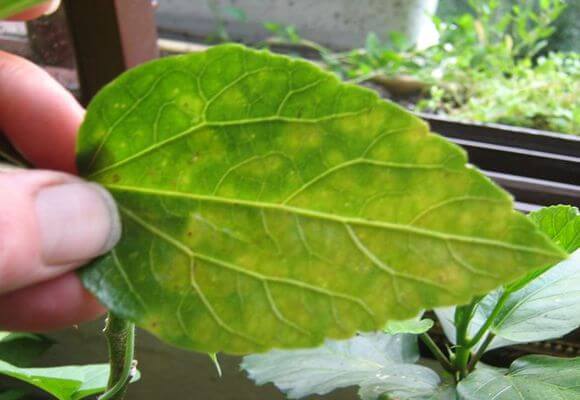

If the bush receives enough light and does not suffer from cold weather, but still loses leaves, they reconsider the methods of care. One routine, incorrectly performed procedure can cause buds and leaves to fall off.
Improper watering, small pot volume
Hibiscus is a tropical plant that requires a lot of moisture only in the hot season. During the cold season, water stagnates if you water it too often. Because of this, the root system begins to rot, growth stops, the leaves fly around due to a lack of nutrients.
In the summer season, watering is sometimes carried out daily, but under the wrong conditions, the plant still lacks moisture and reacts by reducing the area of evaporation - it sheds its leaves. This happens when a bush has grown from a small pot or the soil is not picked up correctly and does not store moisture. Stagnation of water in the sump also indicates a violation of the conditions.
It is easy to check the correctness of the chosen pot and the soil in it - a few hours after morning watering, they examine how wet the soil is in the middle. If the soil is already dry, it's time to buy a larger container, purchase a suitable soil mixture. Adding compost from fallen leaves to the soil will increase the ability to retain moisture, drainage at the bottom of the pot will prevent stagnant water.
A small test will help determine the need to moisten the earth: the soil is raked to a depth of 2-3 cm, its dryness is a sign that the hibiscus needs water. Abundant watering is required in spring, in summer - during growth and flowering, moderate - in winter, when a short daylight hours affects the condition of the shrub.
Excess or lack of nutrients
In the spring of intensive growth and preparation for flowering, the plant is fed with mineral complexes containing nitrogen and potassium once a month. Too frequent fertilization leads to yellowing of the leaves, since the root system receives chemical burns from an overabundance of substances. In winter, organic preparations are introduced - Humisol, Vermisol (2% solution).
The lack of trace elements inhibits the development and growth of hibiscus. Falling leaves, along with yellowness, is a lack of iron.The plant reacts to the deficiency of nitrogen and magnesium by the appearance of spots on the leaf plates, and their weakness and thinning of the stems and leaves are a sign that the bush needs to be fed with potassium. If the plant lacks phosphorus, the tips of the foliage dry out and wither. Chlorosis is non-infectious - nutritional deficiencies are treated by watering and spraying with Ferovit solution (1.5 ml per 2 liters of water).
Stress
Hibiscus reacts painfully to a change of residence. Even turning it with the other side to the window on the windowsill causes negative consequences. Severe stress for a flower - moving to a new room, often adaptation begins with yellowing and shedding of leaves.
Transferring to another pot is also not an easy ordeal. The plant is sick and flies around when, during transshipment, the root system was violated, its integrity was damaged. It will take time to restore and grow new roots, so hibiscus sheds foliage, does not waste energy on it.
Pests, diseases
Buying new flowers in the store, finding plants on the balcony or in the garden in the summer often leads to the appearance of pests and infectious diseases.
Parasites
The cause of infection is soil that has not been disinfected, contact with diseased plants.
| Pest | Act | Disposal method |
| Spiderweb mite | Cobwebs the leaves, stems, provokes the death of the whole plant | Spraying with soapy water Preparations Lightning, Akarin, Vertimek |
| Aphid | Destroys young leaves, buds | Treatment with soapy water, tobacco infusion Preparations Decis, Intra-Vir, Anabizin |
| Gallica | Midge larvae eat the contents of the buds, unopened leaves | Collection and destruction of damaged buds and leaves Soil disinfection |
| Shield | Sucks the juices from the leaves | Spraying with insecticides Actellic |
| Greenhouse whitefly | Damages leaves, causes yellowing | Potassium soap solution Preparations Karbofos, Aktara, Bison |
| Scorms | They settle in the axils of the sheets Suck out juices | Mineral oil treatment, alcohol solution Preparations Confidor, Aktara |
Infections
It is difficult to treat viral and fungal diseases, too quickly the infection ends in the death of the plant. Prevents the appearance of infections by increasing the immunity of the shrub. It is transplanted on time, fed, and the leaves are cleaned of dust. Hibiscus Treatment:
- The flower is removed from other plants, contact with them is limited.
- Collect and destroy all damaged parts. Cut off yellowed leaves, buds, dry shoots.
- The bush is sprayed with an antifungal drug. Apply Domotsvet, Desavid, Citovit. From folk remedies, Trichopolum treatment is used (2 tablets per 1 liter of water).
Hibiscus is unpretentious, will not die after a complete drop of foliage and will grow new shoots instead of cut ones. But proper care and compliance with the conditions of maintenance will allow the plant to look attractive even without flowers, always delight with healthy glossy foliage.
Other articles about colors:
Prevention
To prevent the development of a second disease, the following preventive measures must be taken:
- Temperature indicators should not go beyond the normal range - 18-22 degrees Celsius. Drying out and waterlogging are unacceptable.
- Timely pest control. It is they that lead to deformation of the leaves and the development of diseases. For processing, use Peretrum, Aktofit.
- It is best to use mineral complex fertilizers to apply nutrient formulations on a regular basis.
- The air in the room should be moderately humid, but not dry.
Disease prevention
It is much easier to prevent certain diseases by taking some measures than to treat them later, fearing to lose the entire plant.
Burn
So, sunburn is prevented by the gradual accustoming of greenhouse and indoor flowers to sunlight. They start with a short time, then increase it. The rose is transferred to a permanent sunny place after full adaptation.In the event that the burn could not be prevented, do not panic - having dropped the damaged foliage, the hibiscus will soon grow a new one.
Violation of the irrigation regime
Further it is worth considering the Chinese rose watering system. In the spring and summer period, the plant needs abundant watering, since the hibiscus will need moisture. But pouring the flower is also not worth it, since the leaves will begin to fall off from below. Watering the soil of the flower in the summer is worth once a week. In this case, 2 times a day every day, it is necessary to moisten the leaves of the plant.
In autumn and winter, the flower will need less moisture, so the amount of watering should be reduced to 1 time in 2 weeks. The temperature regime in winter should not be lower than 12 degrees. You need to water the plant with water at room temperature, but keep in mind that the water must be clean. If the lower leaves of the hibiscus have fallen off, and the yellowish ones have begun to grow, then this is a sign that the water has a significant content of chlorine and calcium salts. This is especially true for residents of the city, where the water is chlorinated. This problem can be solved by settling water, a filter or pump room.
An adult hibiscus, with a well-developed root system, consumes and evaporates a large amount of moisture, therefore it needs regular abundant watering. The watering mode should be chosen such that the soil in the pot will always remain slightly damp. But it is extremely undesirable to overdo it here. If you water the plant "in reserve", the soil will quickly swamp, become too dense for the normal functioning of the roots, and they will no longer cope with the work assigned to them.
In addition, in the soil oversaturated with stagnant water, various putrefactive processes are actively developing, which negatively affect the root system and the trunk of the plant and can lead to its death. The gradual dying off of the root system, the lack of nutrients that the roots can no longer supply the plant in full, and lead to the fact that the hibiscus begins to get rid of the "excess" of green mass, as a result of which the leaves first turn yellow and then fall off. If the development of the process is not stopped in time, the plant may die.
If the hibiscus is still small, has not grown into a large bush, then the first steps to save it are to remove it from the pot, remove the rotten blackened roots, treat the remaining root system with fungicidal preparations and transplant the plant into new soil. When transplanting, the roots can be additionally sprinkled with "Kornevin", and the crown of the plant can be sprayed with "Epin". These measures should help reduce the stress of the plant from all procedures and quickly take root in its new place.
For an adult plant, the above rescue procedure is of little use. Fortunately, because of the love for "water-filling", it is rather difficult to fill it. Here, another case is more likely - the danger of drying the plant, to which the hibiscus will react by drooping and wilting of the leaves, which later turn yellow and fall off.
Hibiscus is a thermophilic plant and prefers temperatures in the 18 - 30 ° C range. At lower values, its leaves may partially turn yellow and fall off. The reaction to the heat in the Chinese rose is the same, but here the situation can be saved by high humidity and abundant watering (the main thing is not to overdo it).
In addition, by yellowing and dropping leaves, hibiscus also reacts to sudden changes in temperature, drafts, and cold winds.
Natural laws and stressful situations
Why does hibiscus turn yellow? If single leaves turn yellow and fall off, then, most likely, this is a natural process. The plant discards old leaves as unnecessary, rejuvenates. One or two falls.
If there are many yellow spots in the crown, then the plant cries out for help. He feels bad, he is stressed. What could cause such a condition, only a florist will figure it out. Let's list the possible causes of stress.
1. Improper watering.
Insufficient or redundant. You need to be flexible in grooming.Since the rose does not like both waterlogging and overdrying.
When it's hot at home, the plant needs a lot of water. Sometimes every day. In the cold season, it can suffer from waterlogging. The root system in a wet, heavy substrate is under stress. Feeling unwell is reflected in the whole plant. It is necessary to adjust watering all the time, checking the condition of the soil in the pot.
2. Heat and cold.
The homeland of hibiscus is the tropics. Therefore, the optimal temperature for keeping is from +18 to +30 degrees. If it's hotter at home, the hibiscus is more likely to be thirsty. There is not enough moisture - it sheds leaves. To make it easier to cope with the abnormal heat. At low temperatures, the flower will not die, but will react with yellowing. Therefore, on cold windowsills near frosty glass, the plant will be uncomfortable.
3. Bright sun or thick shade.
Hibiscus love the sun. But midday aggressive rays can scorch the leaves of the plant. Sunburns appear - large white spots. With too intense lighting, almost all indoor flowers are stressed: the leaves of violets turn yellow, the spathiphyllums begin to wither.
Hibiscus grows outraged even with too little light. The sun is essential for the normal process of photosynthesis. Moreover, the surface of the sheet is large. If there is little light, the plant sheds foliage. So it is easier for him to maintain vitality.
4. Drafts and relocation.
Arranging through ventilation in our home, we forget about the comfort of indoor plants. Why can't violets be kept on the windowsill? Why do Chinese hibiscus plants experience extreme draft stress? Gusts of wind dry the leaves - and they lose their greenery.
Hibiscus is not very picky about the conditions of its keeping. But he has one "fad": the plant does not tolerate the permutation of the pot. It always reacts to a new place with yellowing. Better to immediately identify and not touch it later.
5. Overfeeding and underfeeding.
This situation on the list of stressful situations is almost at the very bottom. Roses are rarely informed by yellowing of the leaves for an overabundance or lack of fertilizer. However, you need to remember about feeding.
Watering with tap water leads to alkalization of the substrate. As a result, the leaves turn rich yellow, but do not fall off. It is necessary to transplant the hibiscus or periodically acidify the irrigation water.
Due to a lack of nutrients, chlorosis can begin. The leaves begin to turn yellow gradually: first, the color of the areas between the veins changes. This happens if the hibiscus is not transplanted for a long time or they generally forget to feed.
Frequent fertilization is also harmful. They are especially sensitive to an excess of phosphorus. Wither away before our eyes. Gradual and moderate application of phosphorus-containing dressings stimulates flowering. If you give a lot of this element at once, the leaves will turn yellow.
To understand the specific cause of hibiscus problems, analyze your particular plant. Where does it stand? How long has it been transplanted? How often is it watered? Etc.
Output
There are many reasons why Chinese rose leaves turn yellow. It is important to immediately eliminate them, because such a symptom speaks of some kind of flower problem. This plant enchants with its lush crown and attractive multi-colored flowers. We can safely say that healthy hibiscus is a decoration of any home.
Hibiscus is a large genus of plant that is great for growing in greenhouses. A Chinese rose is suitable for home cultivation. Although hibiscus is unpretentious to care for, beginners often wonder why hibiscus leaves turn yellow. Consultation of a specialist in this matter will be relevant. The reasons why hibiscus leaves turn yellow? What to do? Ways to solve the problem with a photo from specialists.
Why does hibiscus shed its buds?
Chinese rose buds turn yellow and crumble for several reasons:
- If, during budding, the hibiscus pot is rearranged from place to place. The pot should be in one place.
- If the plant is in a poorly lit place. Move it closer to the light.
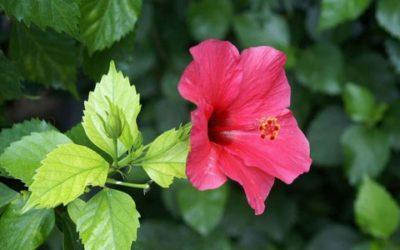

If the flower is watered with cold water. Water for irrigation should be used at room temperature and separated. You can use melt water after defrosting the freezer.- When the soil dries out in a pot. Water it regularly, in the morning or evening, every two days.
- With strong waterlogging of the substrate.
- With a lack of fertilizer. During the growing season and flowering, hibiscus requires more nutrients than during the rest period. It must be fed with a complex fertilizer, in which the minimum amount of phosphorus. From an excess of phosphorus, the leaves turn yellow. Top dressing should be applied in cloudy weather, in well-moistened soil.
- If the plant has the wrong soil. The soil should consist of two parts of turf and one part of humus, leafy earth and sand.
After finding out the reason for the yellowing of the leaves of the Chinese rose, and after removing it, the flower will quickly recover. Long shoots can be trimmed at this time.
In addition, you can find out why the buds and leaves of hibiscus fall off here, and here we also talked about why the plant does not bloom.
Photo
In the photo below, you can see yellow spots on hibiscus foliage, as well as other signs of yellowing.
Hibiscus lovers may find the following articles useful:
- leaf diseases;
- drying out of roots, stem and tips of leaves;
- rolling leaves;
- dropping buds.
Prevention of hibiscus diseases and preventive measures of pest control (video)
Hibiscus is the common name for numerous plants of the Malvaceae genus. Some of its representatives are quite familiar with the conditions of the city, in the garden and at home. In home flower beds, the Chinese look is more common. It is also called the "Chinese rose".
The plant is attractive at any stage of its development. Even when there are no flowers, its lush crown of large, rich green leaves looks great. Naturally, if yellow spots appear in this emerald hat, anxiety arises. But it is not always justified. To understand why the leaves of hibiscus turn yellow, you can only analyze the conditions of detention. In the article, we will name the probable reasons that will help you navigate and take appropriate measures.
Brief description of the culture
Since the plant is very sensitive to low temperatures, it is more often grown in greenhouses and greenhouses than outdoors. The preferred temperature for him is about 25-30 degrees in summer and 10-12 in winter. If the summer is not warm enough, flowers will not appear on the plant. The flowering period of the Chinese rose is quite long - from the very beginning of spring to mid-autumn.
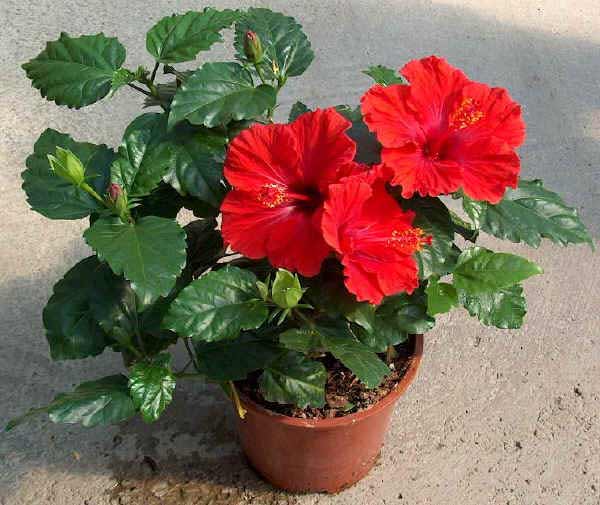

Hibiscus
In height, hibiscus can reach two to three meters. Its life span is about 20 years.
Important! When growing hibiscus, you need to take care not only of the air temperature. Adequate lighting is essential.
What if he dies?
If your Chinese rose is sick, do not despair, it may be possible to revive it. Hibiscus is unpretentious and can be treated at home.
At the moment, many drugs have been developed for pest control, they can be purchased in specialized stores or you can use folk methods by treating the plant with a solution of soap, tincture of tobacco or pepper.
Folk remedies for controlling hibiscus pests
Tincture of pepper (from aphids, ticks) -
Dry pepper is poured with water in a ratio of 1: 2 and boiled for an hour, then insisted and filtered. To spray a plant, 10 g of the drug is diluted in one liter of water and soap. You need to take about 5 g of soap per liter.
Tincture of tobacco (from aphids, thrips, ticks) -
1 kg of tobacco dust or tobacco is boiled in 10 liters of water for two hours. Insist for two days and filter. Before use, the concentrate is diluted in 10 liters of water with 50 g of soap.
Soap solution.
To prepare the drug, 200 g of potassium soap is diluted in 10 liters of water.
Mustard tincture (for ticks, aphids) -
50g of mustard is boiled in a liter of water and infused. Before use, the concentrate is diluted in 20 liters of water.
Agricultural technology is of great importance in keeping hibiscus: soil acidity, heat and light conditions, air and soil moisture. Create comfort for the flower: do not move, treat pests, loosen the soil and water once a week and gradually the hibiscus will grow new leaves.
Hibiscus sheds leaves due to lack of lighting
Normal access to sunlight is a real source of life for the Sudanese rose. With a lack of light, the plant can actively shed its leaves, thus trying to reduce its need for lighting. This process can continue until literally a couple of leaves remain on the hibiscus.
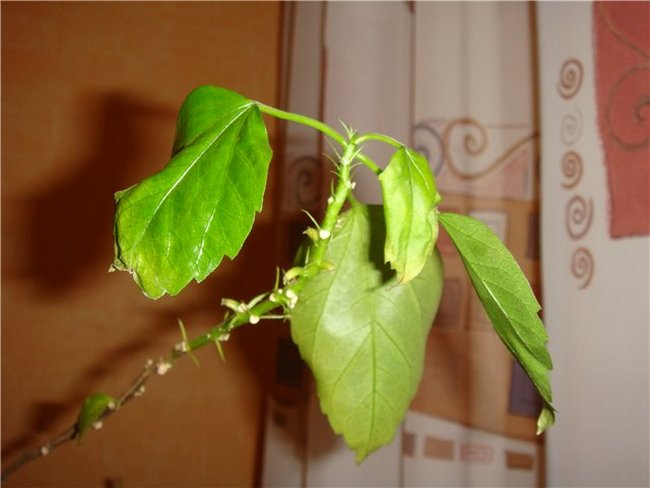

2. Incorrectly selected level of illumination
Hibiscus is a rather shade-tolerant plant, but if there is too little light, then it will surely react to such a disregard for its needs with massive yellowing and leaf fall. As a rule, flower growers often face a similar problem when moving their pet from the street (from the garden or from the balcony) to the house. The abrupt change from the habitually bright sun to a semi-dark room causes stress in the plant. To help him acclimatize faster and survive the move without loss, it is necessary to use additional lighting with phytolamps.
The opposite problem is leaf sunburn, due to which delicate leaf plates become covered with yellow, white, and sometimes shapeless spots burned to blackness. In order to avoid such troubles, the hibiscus taken out into the fresh air should be accustomed to the sun gradually, providing it with shading at midday. The same measures should be taken for plants placed on the south window.
Preventive measures
So that the leaves of the Chinese rose always remain green and healthy, comply with the following conditions:
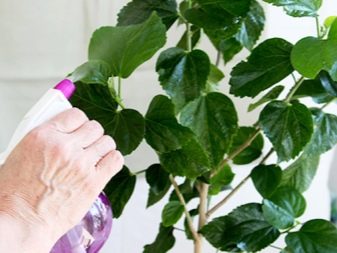

For information on why the Chinese rose sheds buds, see the next video.
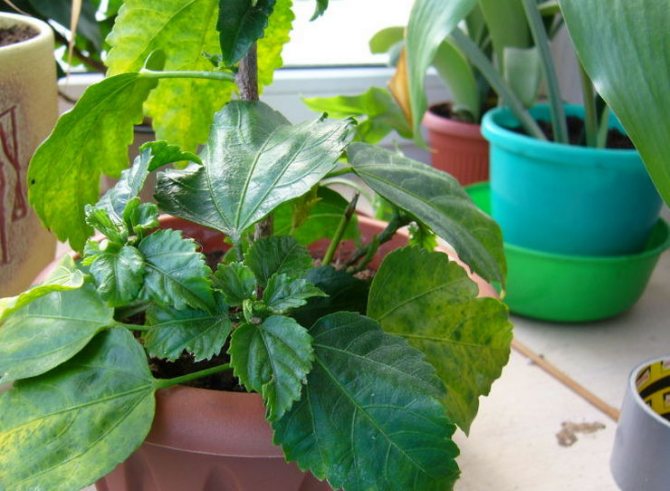

Known to most indoor flower lovers, the Chinese rose or hibiscus (Hibiscus rosa-sinensis) is considered an exquisite and luxurious plant and is grown by many growers at home. This indoor pet attracts attention with its unusually bright and large-sized red, pink, lilac, yellow or white flowers against a background of rich rich green foliage.
Hibiscus is a capricious plant, it is necessary to care for it strictly according to certain rules. Indeed, with the slightest changes in favorable conditions of detention, the Chinese rose responds with the loss of its decorative qualities. Then suddenly the leaves begin to turn yellow, and then a real leaf fall happens. This behavior of an indoor flower must have an explanation. It is possible that this is due to illness or the appearance of pests, or maybe the hibiscus is under stress.It is important for a flower grower to quickly establish the cause of negative changes and take urgent measures to save the plant.
Leaves turn yellow - what to do?
When hibiscus sheds its leaves, what should be done in this case? Earlier it was said that leaf fall is one of the variants of the shrub disease, therefore, in some cases, the disease will have the same reasons as the yellowing of the leaves, that is:
- flowering, that is, preparing the plant for the winter period;
- problems with watering and lighting, that is, insufficient first and / or second;
- spider mite infestation;
- sunburn;
- low temperatures.
Accordingly, the methods of treatment will be similar. However, there are additions. So, when the leaves fall, it is necessary to check the condition of the plant's root system - if the roots are dry or rotten, they must be cut off, and the plant must be transplanted into a new pot or to a new site, if the shrub is planted in open ground.
Yellowed leaves are not the biggest problem. Even a novice flower lover will be able to revive the plant if he follows the recommendations of experienced flower growers.
If you cannot arrange the plants so that each of them has enough natural light, use artificial lighting. The best help in this regard is fluorescent lamps.
Due to the lack of nutrients in the soil, the top leaves of plants usually turn yellow. To save indoor flowers from starvation, increase the dosage of fertilizing or simply fertilize the plants more often. But do not bend: from an excess of fertilizer in indoor flowers, problems can also begin.
Very often leaves of plants infected with viruses turn yellow. A characteristic sign of infection: the leaves not only turn yellow, but also become covered with spots. For example, chlorosis of indoor plants is a disease that disrupts the natural processes of photosynthesis. The leaves turn yellow and fall off, the tops and weak roots of the plant can die off. If signs of chlorosis are found, feed the diseased plant with a complex mineral fertilizer such as "Uniflor-Micro".
Sections: HouseplantsPests of indoor plantsDiseases of indoor plants
Care errors
Floristics knows more than 200 species of this plant, but the Chinese rose subspecies is most suitable for home maintenance. But indoor hibiscus, like all living things, can get sick. Its leaves will immediately tell us about this. Errors in cultivation and care that affect the condition of the plant are:
- high temperature;
- the influence of drafts and direct sunlight;
- increased soil moisture;
- lack of drainage;
- watering with cold, unstable water;
- bad light.
Violation of internal processes is always accompanied by external manifestations. Yellowed hibiscus leaves signal a kind of stress, the flower is worried about something. The tricky part is finding the root of the trouble. The Chinese rose reacts equally to various forms of disease or pests. In other words, she expresses any dissatisfaction with yellowing and shedding of leaves. The first thing worth paying attention to is leaving. If you have taken the wrong approach to a flower, then he is probably trying to say so. Be that as it may, you should find out the reason why the leaves of hibiscus turn yellow and fall off. It is important to provide the flowers with proper nutrition. The same applies to the water balance. A person is 80% water, so its use is a part of normal life. At the same time, excess water leads to a deterioration in well-being. Plants show the same trend.
Violation of the watering regime
Over time, you can notice that when pouring with settled water, the leaves of the hibiscus turn yellow - this means that the ground is very wet, you need to stop watering, switching to spraying. It is also necessary to change the ground, rinse and cut off rotten roots.Hibiscus 4-5 years old requires daily watering.
It is also important to ensure that the soil in the flowerpot is slightly damp before the next watering. Damp soil becomes dense, and fungal diseases develop in swampy land, young plants suffer from this. The soil in the pot should not dry out either, since the hibiscus leaves will turn yellow and can completely crumble. To do this, you need to water regularly, spray the leaves every day in summer and once a week in winter.
Incorrect lighting
Consider the reasons why hibiscus leaves turn yellow when there is little light for it. He, like all representatives of the flora, produces chlorophyll during daylight hours, and if there is little light, then a kind of natural selection takes place. The old leaf has fallen off, and the new one, in turn, receives the required amount of light. The rose loves the sun and grows well in the shade, but cannot stand changes in lighting. But what if there is little light in the apartment? Create artificial lighting. In the period of the scorching sun, on the contrary, the rose should be shaded in order to avoid burns.
Unsuitable temperature
Although the Chinese rose is a plant from the tropics, it still does not tolerate sudden changes in temperature. In addition, she is afraid of the heat and cannot stand the cold. In cases where the hibiscus is cold or very hot, the leaves turn yellow and fall off.
The optimal temperature regime is 22 degrees Celsius.
Excess and lack of fertilizers
With frequent fertilization of the soil, the plant's body experiences stress, something like an excess of sugar in the blood of a person, and reacts to this with yellowing leaves. We can help hibiscus deal with this. Fertilizing the soil of indoor flowers, you need to know exactly the dosage and type of substances that they feed on.
For the development of hibiscus, fertilizers with elements of potassium and magnesium are most suitable, they can be applied without fear. Phosphorus fertilizers, diluted in water, increase flowering, while high phosphorus fertilizers can destroy the flower. Nitrogen fertilizers must be applied without exceeding the norm. This is a rather dangerous substance that leads to nitrogen burns.
How to save a flower
Imagine a situation: you brought a fresh new hibiscus you just bought from the store, but after a few days you noticed that it was dropping leaves that had turned yellow. This is primarily due to the stress of transportation. To save the plant, we treat the plant with "Epin" once a week, repeating the procedure 2-3 times.
If the leaves continue to fall within three weeks, then an urgent need to check the roots. They must be washed, cut off dry and spoiled ones, and the plant must be transplanted into a new flowerpot. Given the variety of reasons why a plant turns yellow, diseases cannot be ruled out. To prevent infection, hibiscus must be examined, often sprayed and ventilated. In the fight against insects, Fitover helps. Against fungi, drugs with a special composition are used.
[collapse]
Follow-up care
The Chinese rose will freely grow new foliage after being cured and freed from pests. To do this, you need to remove all dried branches and leaves. Every spring, a young plant needs a transplant, it is done by the transshipment method, and the flower is transplanted each time into a more spacious pot, leaving room for root growth.
The hibiscus is transplanted into light and nutritious soil. It is desirable that it consists of leaf - 1 part, turf - 2 parts and humus earth - 1 part. In addition, coarse sand is added to the soil, bone meal can be added. Drainage is laid at the bottom of the pot, which can consist of broken brick, ceramic shards, crushed stone, gravel or expanded clay. The main condition is that drainage should not injure the roots.
To form a beautifully shaped bush, you will need to trim shoots that are too long. Old, dry, damaged or weak shoots are removed. Sometimes they pinch the tops of the shoots of a young plant to form a crown.Places of cuts are powdered with charcoal. After trimming, the room temperature is lowered by 2 ° C. Do not overdry the soil, so every day the plant should be sprayed with water at room temperature.
An adult flower that is more than 3-4 years old is transplanted every 3-4 years. Every spring, a small layer of new soil is added to the pot on the old soil.
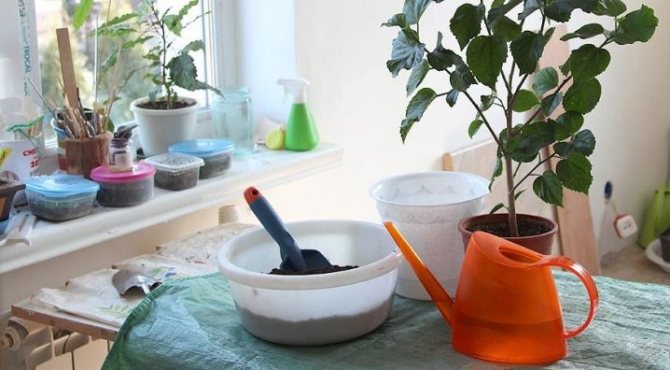

Dormant period
In order for a hibiscus to grow beautiful, bloom magnificently and not get sick, it is necessary that it is properly cared for during the rest period.
First, he needs to do a trim
... This should be done not only to form a bush, but also in order to remove weak, poorly formed shoots. There will be no flowers on them anyway.
Reference!
During the dormant period, the flower prepares for a beautiful lush flowering. Accordingly, the conditions of detention should be optimal: the air temperature should not be lower than 150 C.
Viruses infecting hibiscus
Often the plant suffers from viruses. The planting material itself and the substrate in which the flower grows can be affected. Hibiscus is susceptible to two types of virus:
- Bronze. At first specks of golden color are formed on the leaves, which then darken. The plate eventually becomes wrinkled and rough.
- Annular spotting. This viral disease gets its name from the characteristic yellow rings that appear on the leaves.
Hibiscus infected with the virus, unfortunately, cannot be saved. The specimen must not only be removed, but also destroyed, including the substrate. This is required to be done with the appearance of the first symptoms.
What to do?
So that the leaves of the hibiscus do not turn yellow and do not fall off, and the rose can live comfortably at home, it must be properly looked after all year round, monitor the health of the flower and protect it from pests.
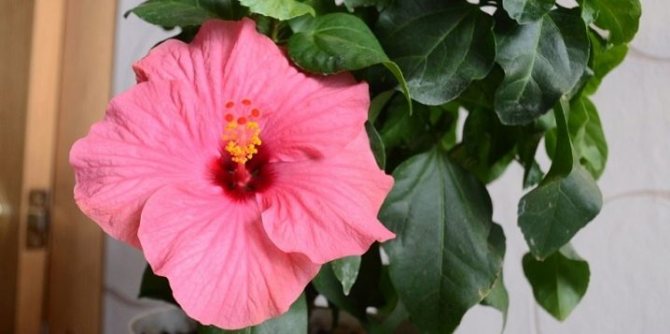

Replacing the flower pot
A small pot does not allow the rose to grow and develop correctly, so it is changed to a large one, which is 2-3 cm wider in diameter than the previous one. The flower is transplanted by the transshipment method so as not to harm the roots. The hibiscus is placed in a new pot with moistened soil and drainage, watered only on the third day.
Excess water in the pan indicates that the pot is too large for the plant. It is replaced with a smaller one so that the roots do not rot and the plant die. Before transplanting a flower, examine its root system, clean it from the ground, remove decayed fragments, treat the roots with a fungicide solution and sprinkle the sections with Kornevin powder or crushed activated carbon. After transplantation, the flower is sprayed with "Zircon" or "Epin".
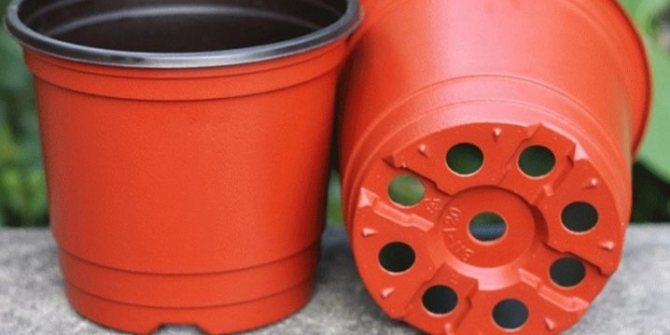

Proper watering
For the lush flowering of the Chinese rose, the development of beautiful and healthy foliage in the summer, the flower is watered abundantly. The main thing is not to overdo it, the plant is watered again after the top layer has dried by 2-3 cm. The ground should not be either dry or wet, but constantly wet. In hot windy weather, it is recommended to water the flower every day, or even 2 times a day, as well as spray it with water.
In winter, the Chinese rose is dormant, but this does not mean that it does not need to be watered., you just need to increase the time between waterings. Heating dries out the air in the room during the cold season, so it is important to spray the flower and the air next to it, and place a vessel of water next to it. Dry air can cause illness.
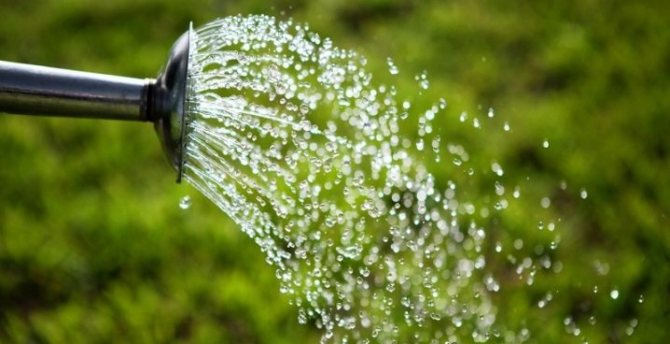

Top dressing
Chlorosis disease occurs in a plant due to irrigation with untreated and unsteady water. It is better to transplant the Chinese rose into new soil or feed it with complex fertilizers that contain magnesium but no lime. Epsom salt or magnesium is sometimes used in chelated form. Iron chelate is added to the water that is poured over the flower if there is a lack of iron.
You need to feed the Chinese rose in the morning or after sunset on cloudy, cool days. From the beginning of spring to September, the flower is fed once a week, or fertilizers are applied more often, but in reduced doses. In winter, feeding is applied only to flowering plants and only once a month. Some gardeners use water with added sugar as a top dressing - half a teaspoon of sugar in a glass of water.
Hibiscus is fed with nitrogen fertilizers with caution - oversaturation leads to burns. Brown spots appear on the leaves, indicating that the plant is oversaturated with nitrogen. Leaves gradually die off, and the flower dies. To save the rose, she is given a break from dressing. Two weeks are watered with clean water without impurities. When the plant recovers, they feed and add nitrogen in small doses, gradually adjust the concentration to an acceptable value.
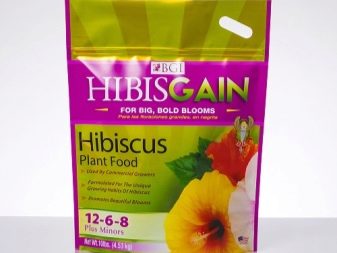

Spider mite control
They begin to fight pests hastily, otherwise it will not be possible to save the flower. If the parasite did not have time to severely damage the leaves, then the foliage and stems are thoroughly washed with soapy water. If the lesion is serious, then the rose must be treated with insecticides. The leaves are sprayed on both sides. For this, preparations are suitable - "Fitoverm", "Aktofit", "Fufan", "Antiklesh", "Aktellik". Spraying is carried out every 4-5 days 4 times in a row.
In addition, vessels with water or humidifiers are placed next to the flower. Spray the plants and the air around them with water 1-2 times a day. It is important to create moist air around the flowers. Mites are afraid of moisture. They will die in the humid air. The leaves will remain green and beautiful.
To fight the mite, flower growers also use folk remedies. For this, 1 part of dry red pepper is poured with 2 parts of water, boiled for 1 hour, filtered. The hibiscus is treated with soapy water, to which 10 g of the resulting solution with pepper is added.
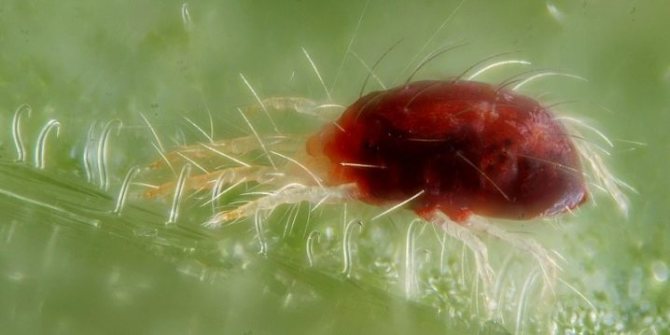

Natural causes
Some indoor plant lovers begin to panic, even if one or two leaves have fallen from the hibiscus, or they have turned a little yellow. This happens when the hibiscus is actively developing, it has many new leaves, and the old ones die off. There is nothing wrong with this process, natural changes take place in living nature.
Stress
Hibiscus reacts painfully to a change of residence. Even turning it with the other side to the window on the windowsill causes negative consequences. Severe stress for a flower - moving to a new room, often adaptation begins with yellowing and shedding of leaves. Transferring to another pot is also not an easy ordeal. The plant is sick and flies around when, during transshipment, the root system was violated, its integrity was damaged. It will take time to restore and grow new roots, so the hibiscus sheds foliage, does not waste energy on it.
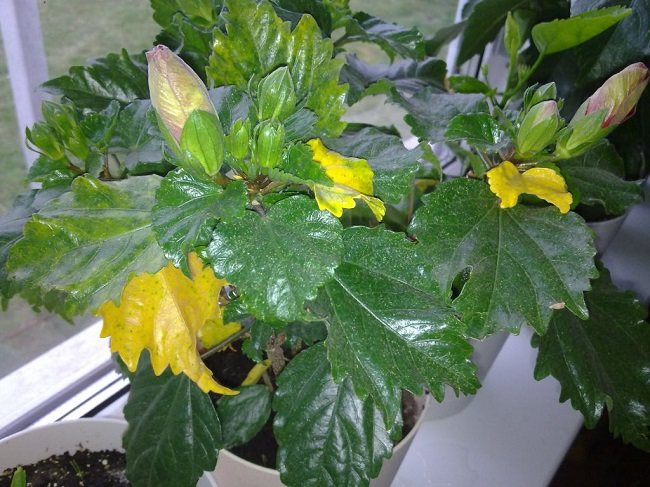

Infections from other plants
It is difficult to treat viral and fungal diseases, too quickly the infection ends in the death of the plant. Prevents the appearance of infections by increasing the immunity of the shrub. It is transplanted on time, fed, and the leaves are cleaned of dust.
Hibiscus Treatment:
- The flower is removed from other plants, contact with them is limited.
- Collect and destroy all damaged parts.
- Cut off yellowed leaves, buds, dry shoots.
- The bush is sprayed with an antifungal drug. Apply Domotsvet, Desavid, Citovit.
- From folk remedies, Trichopolum treatment is used (2 tablets per 1 liter of water).

